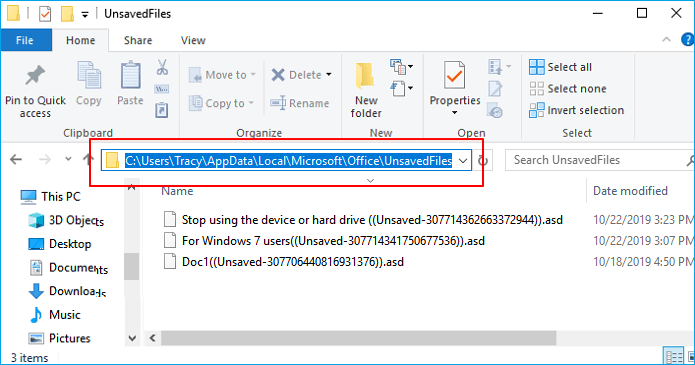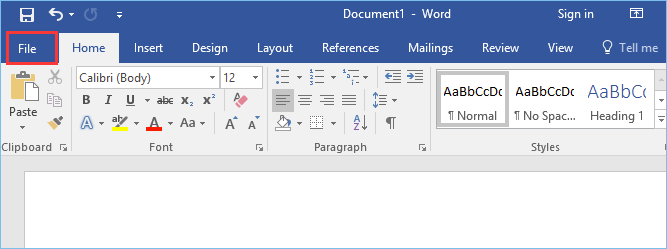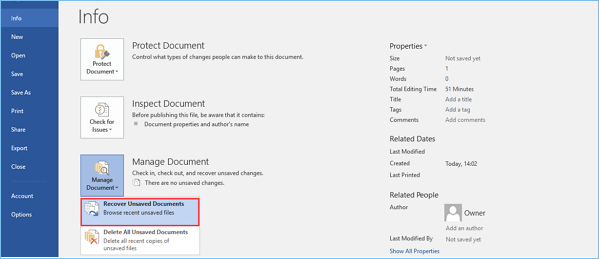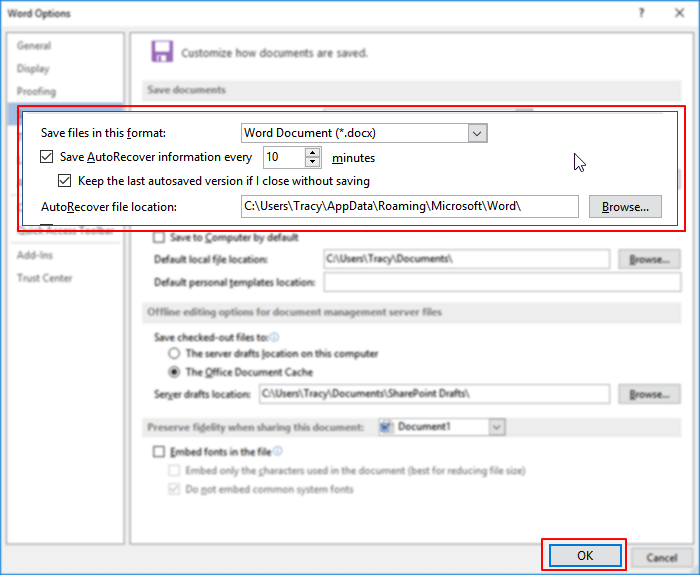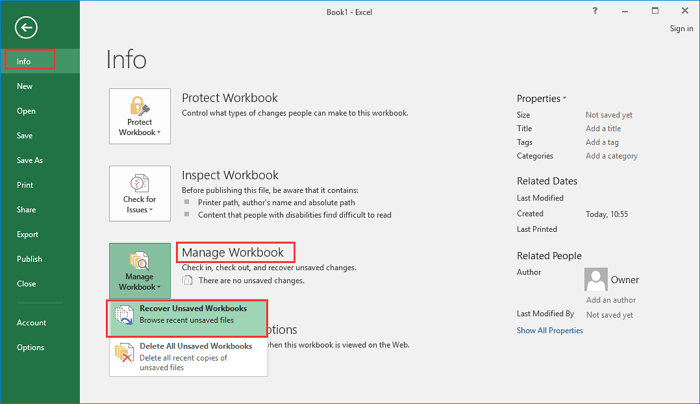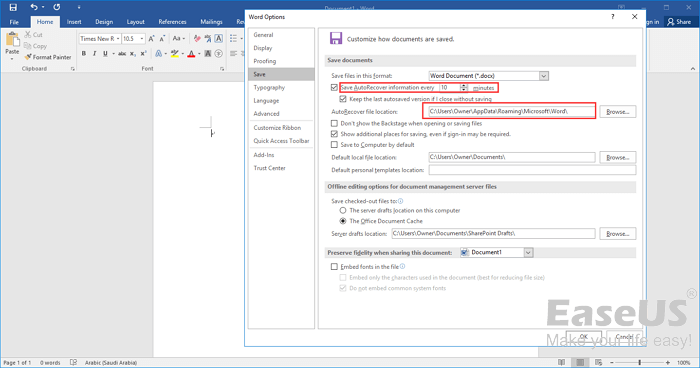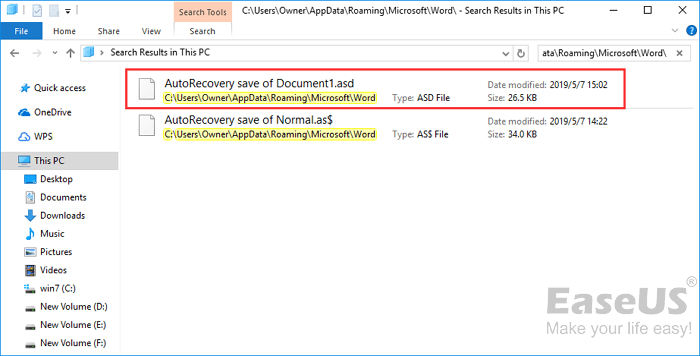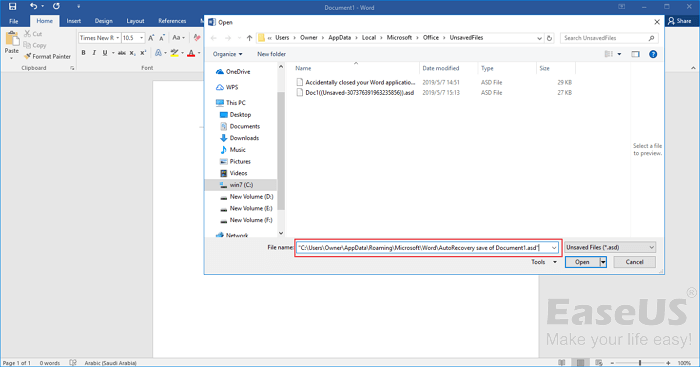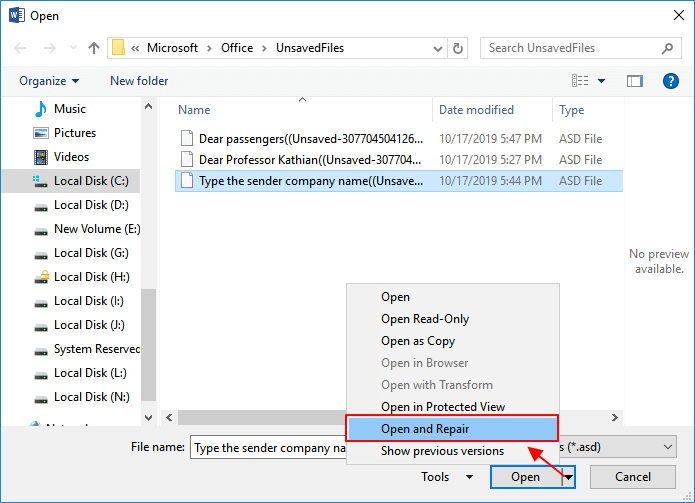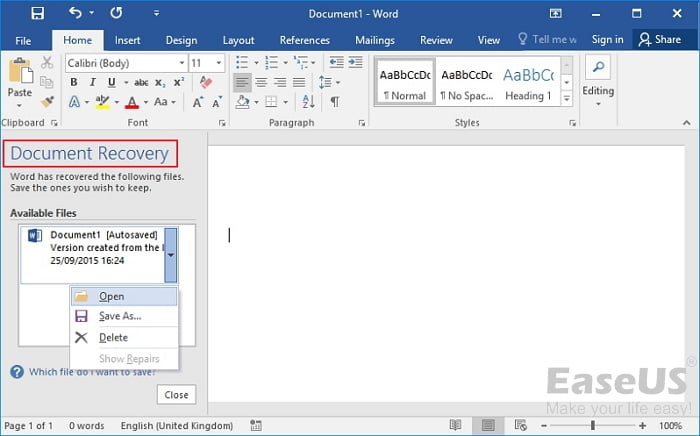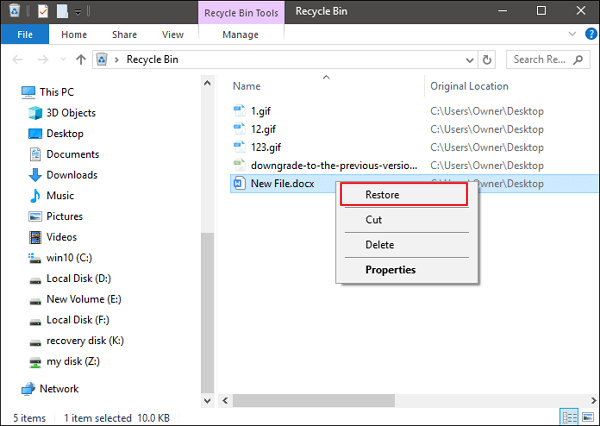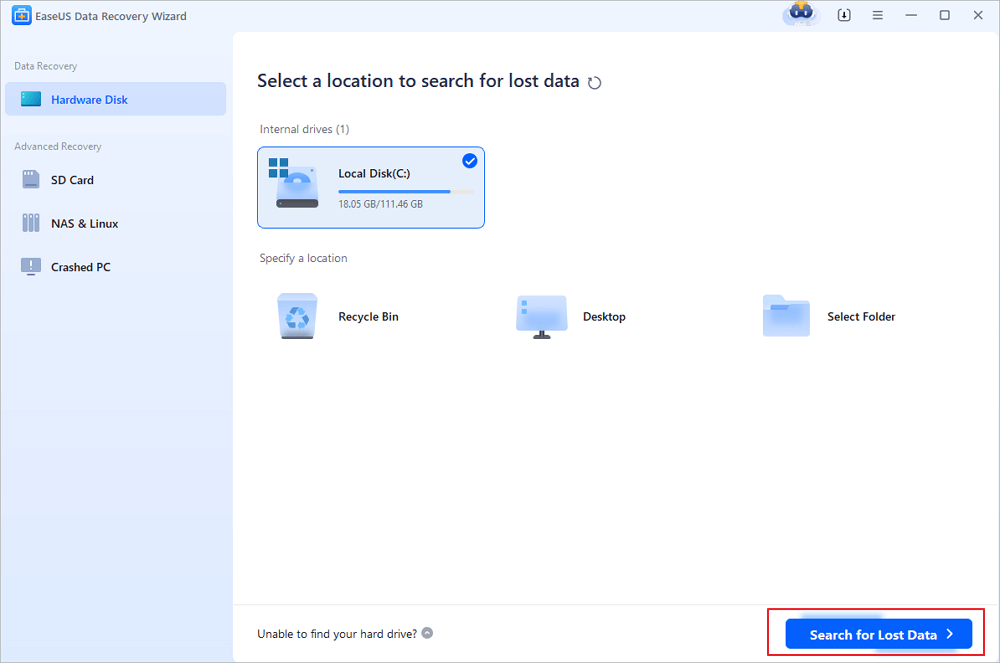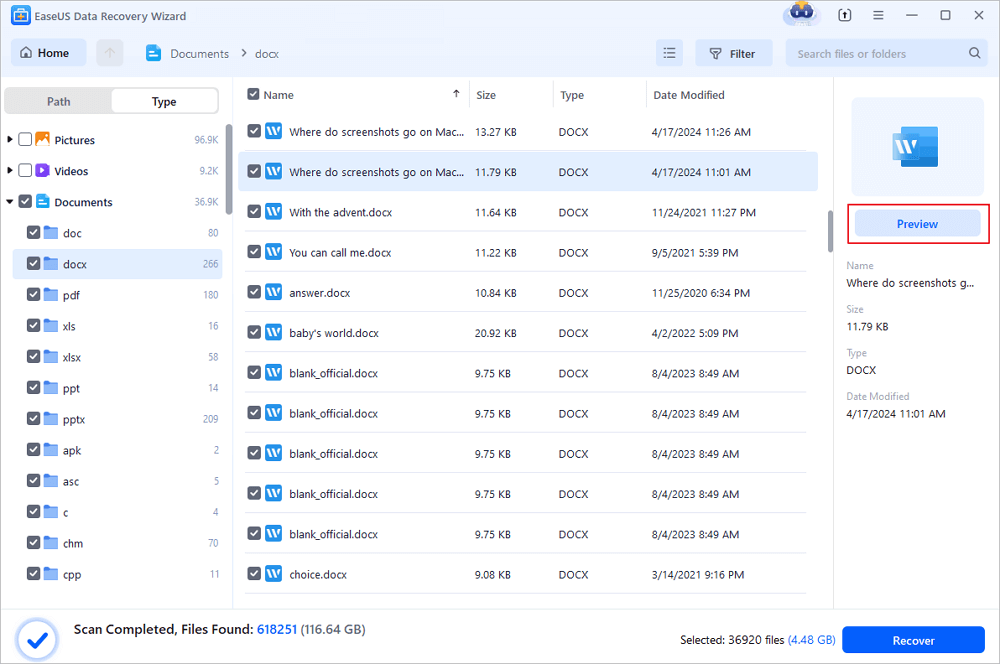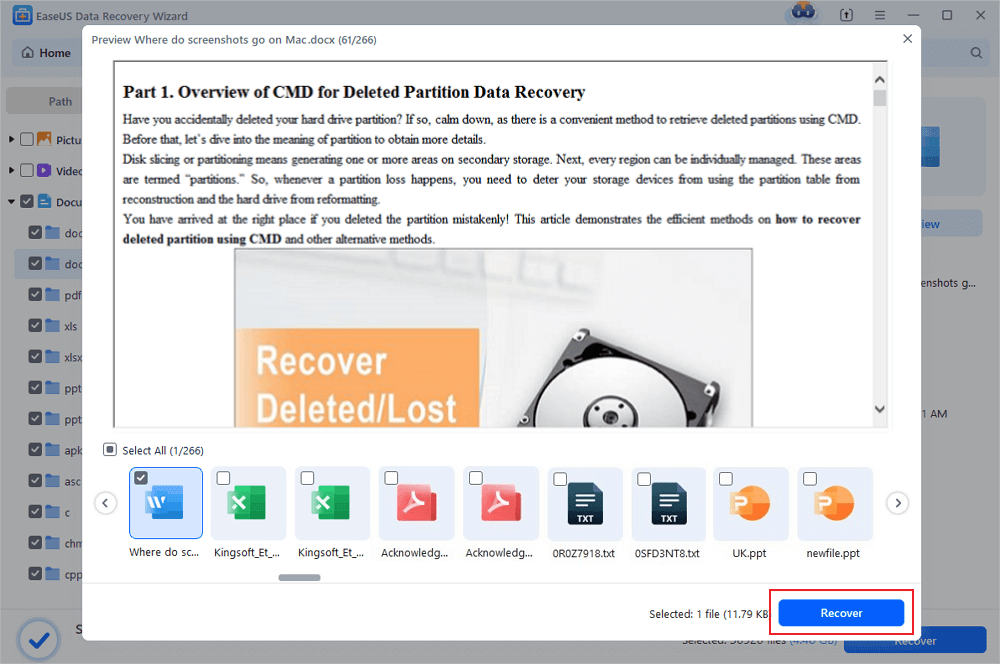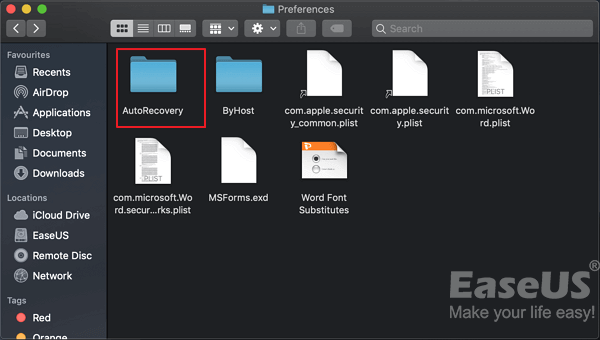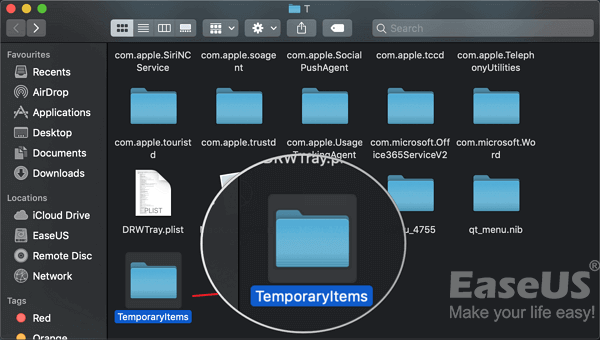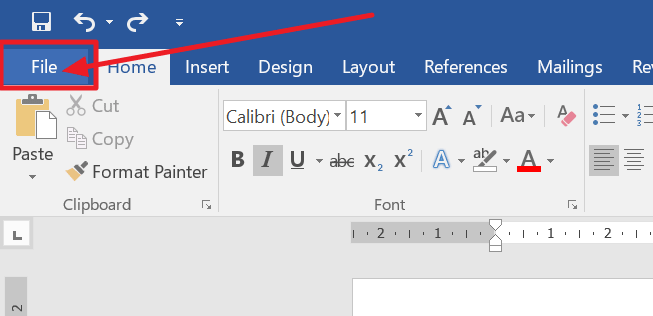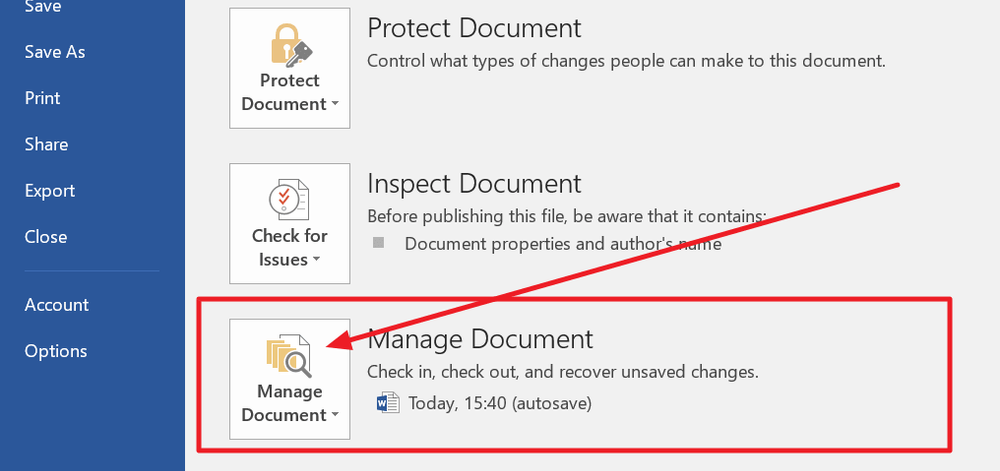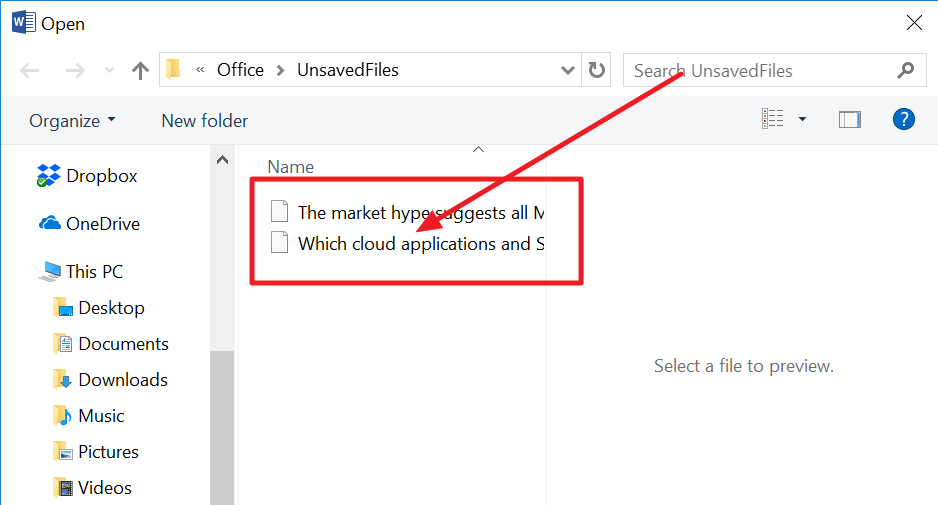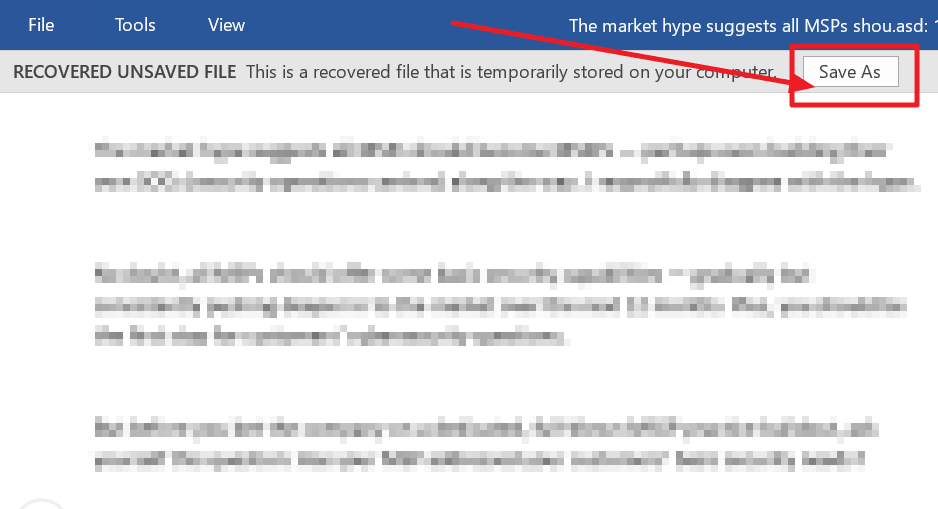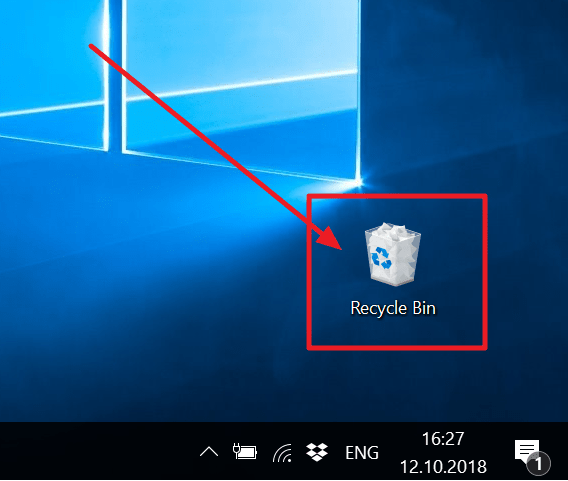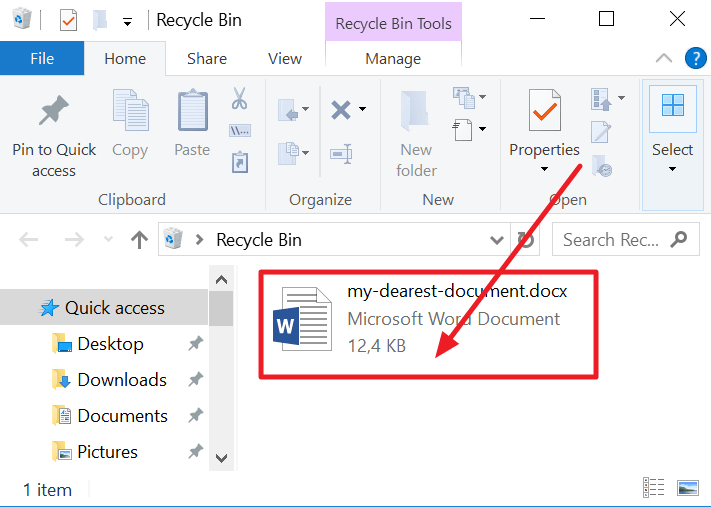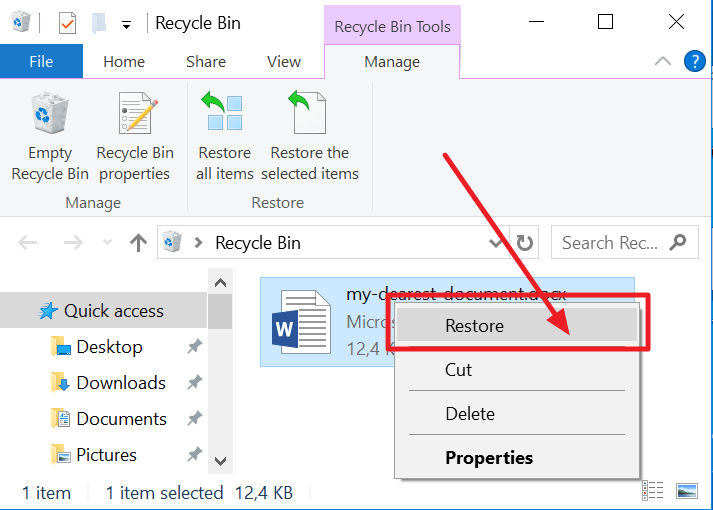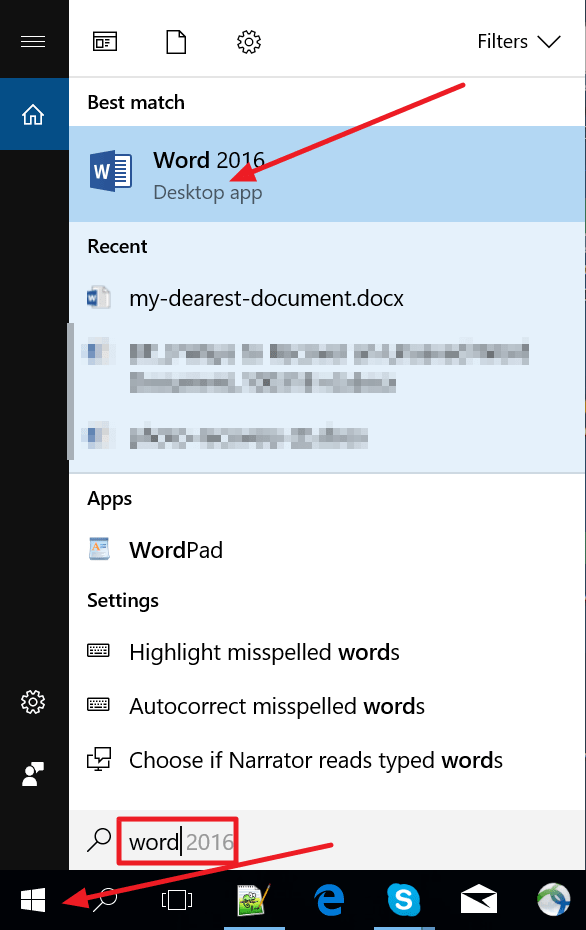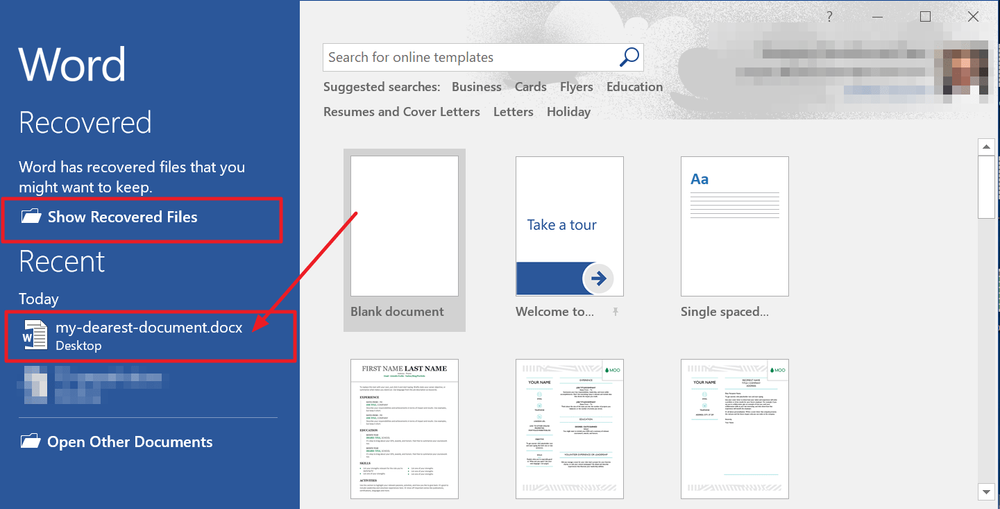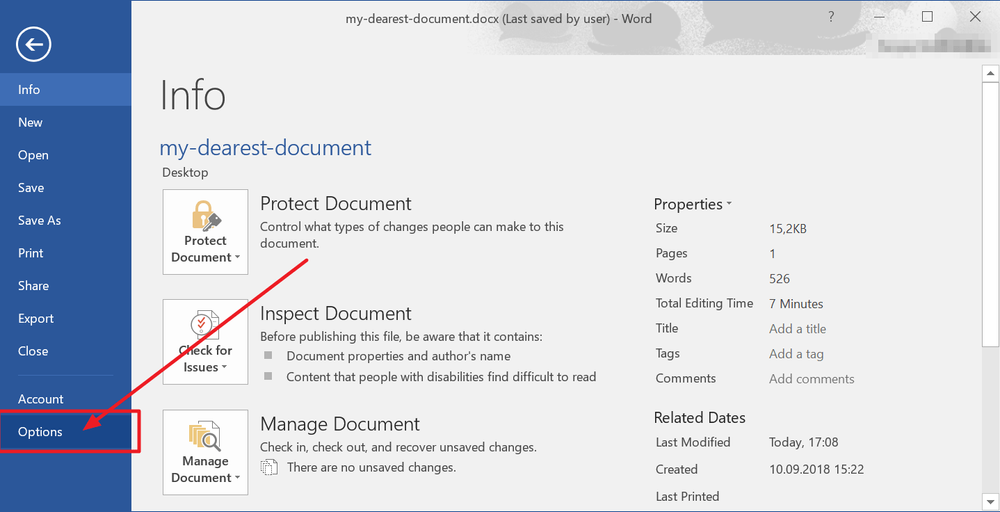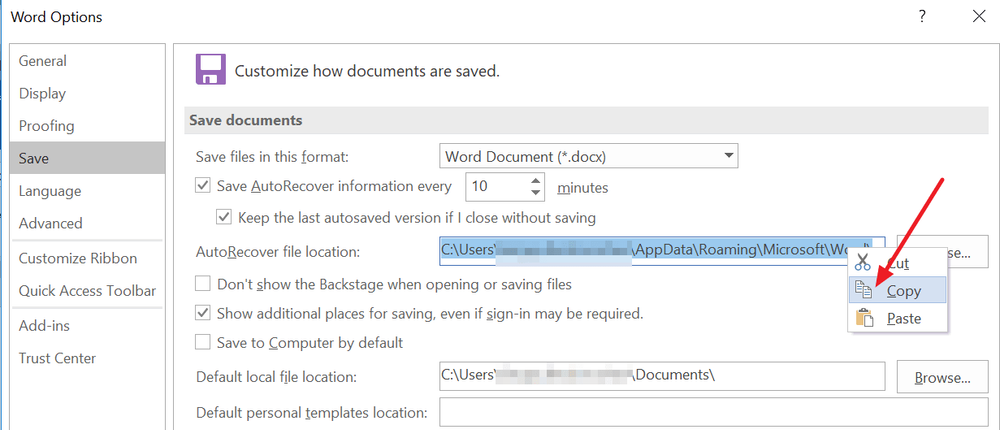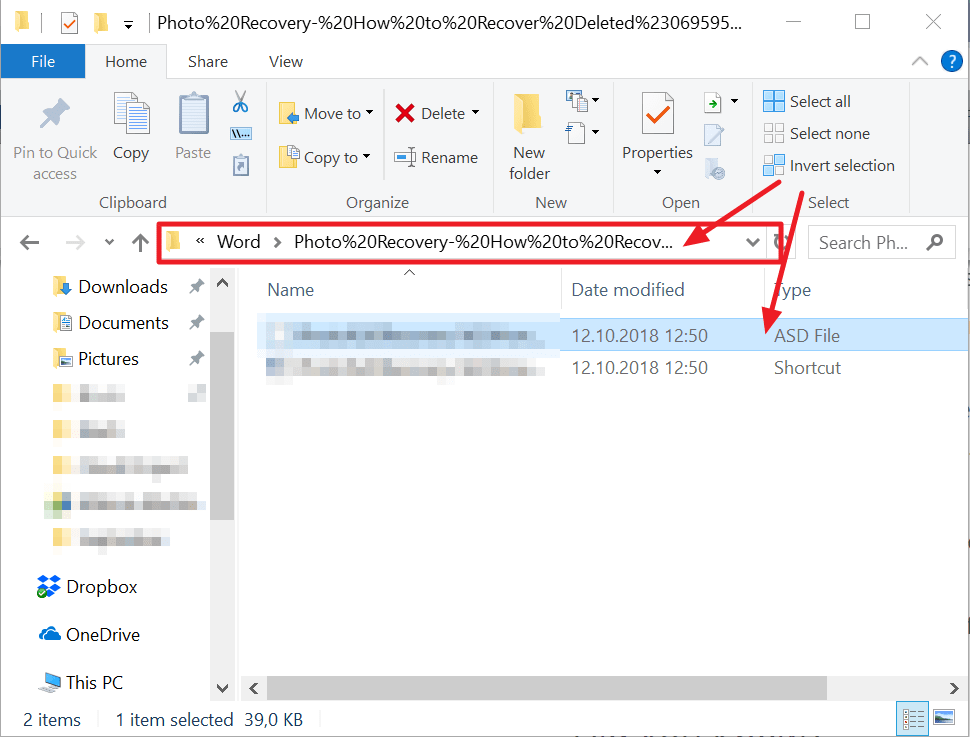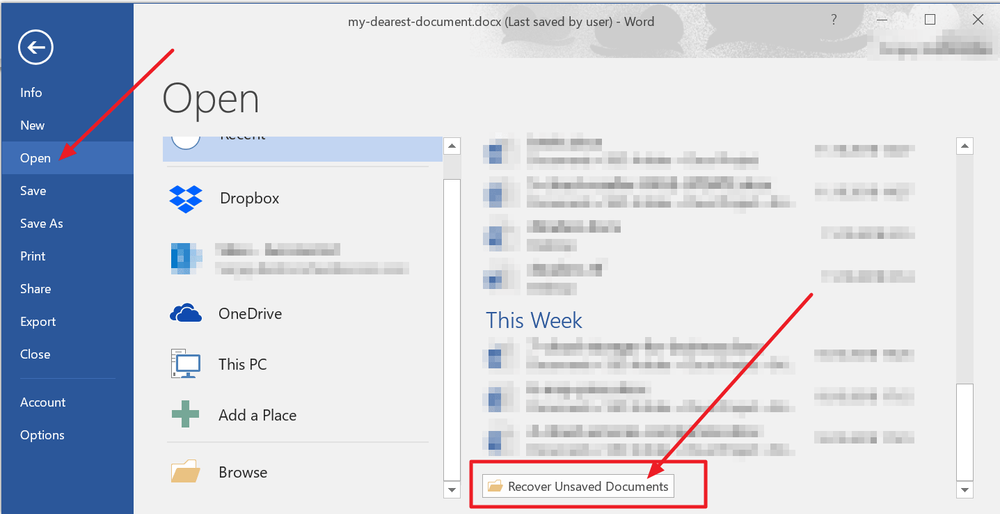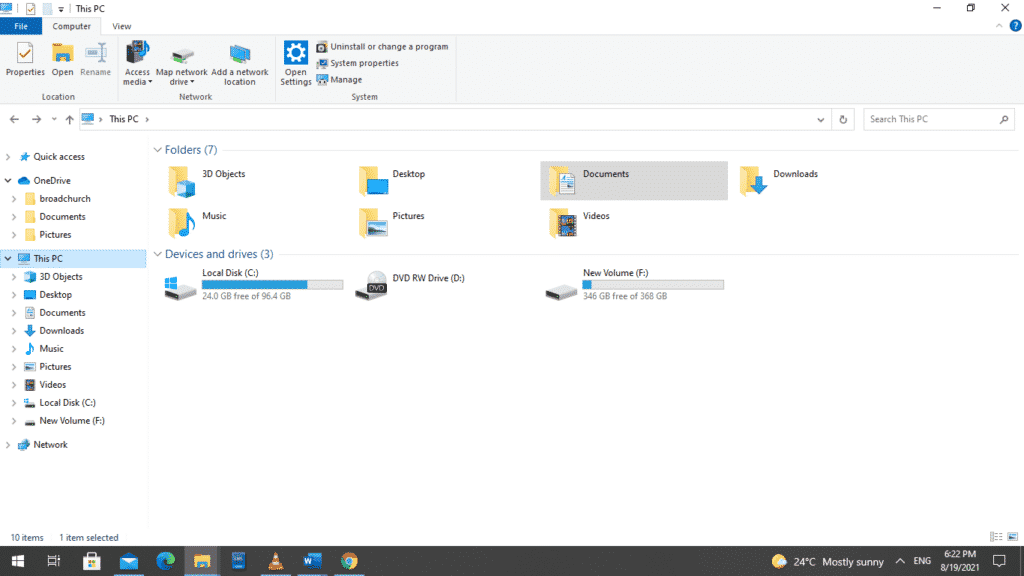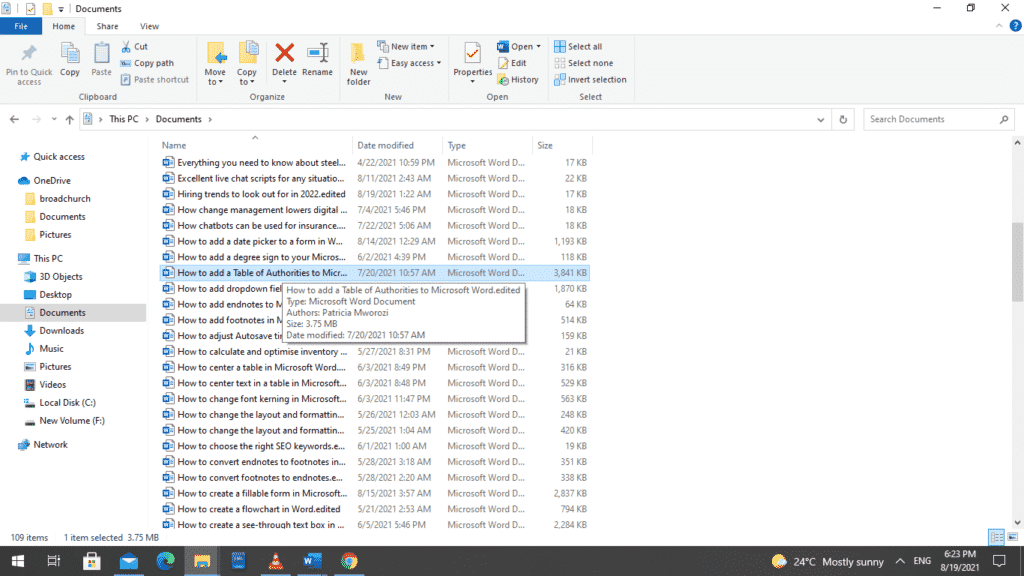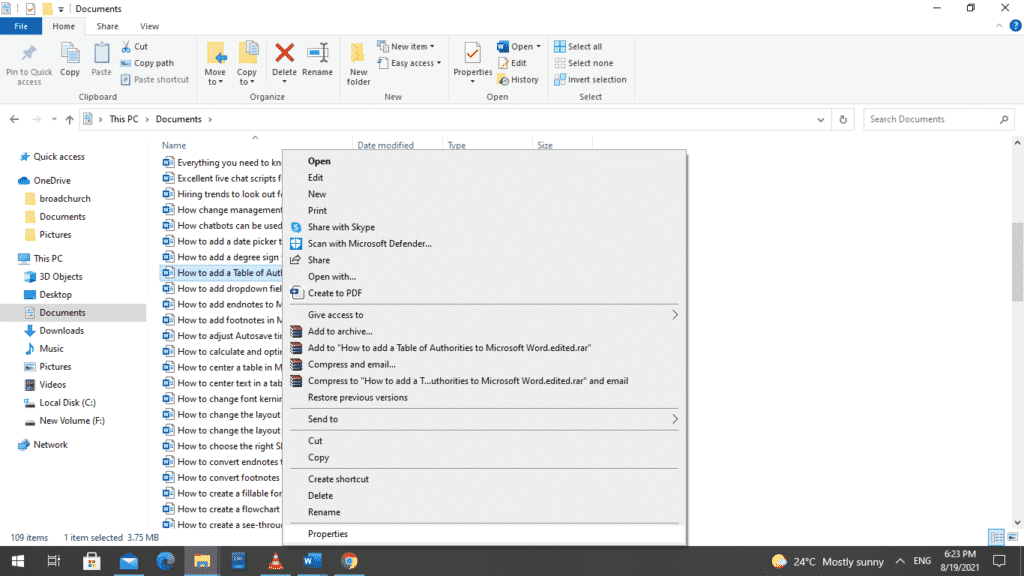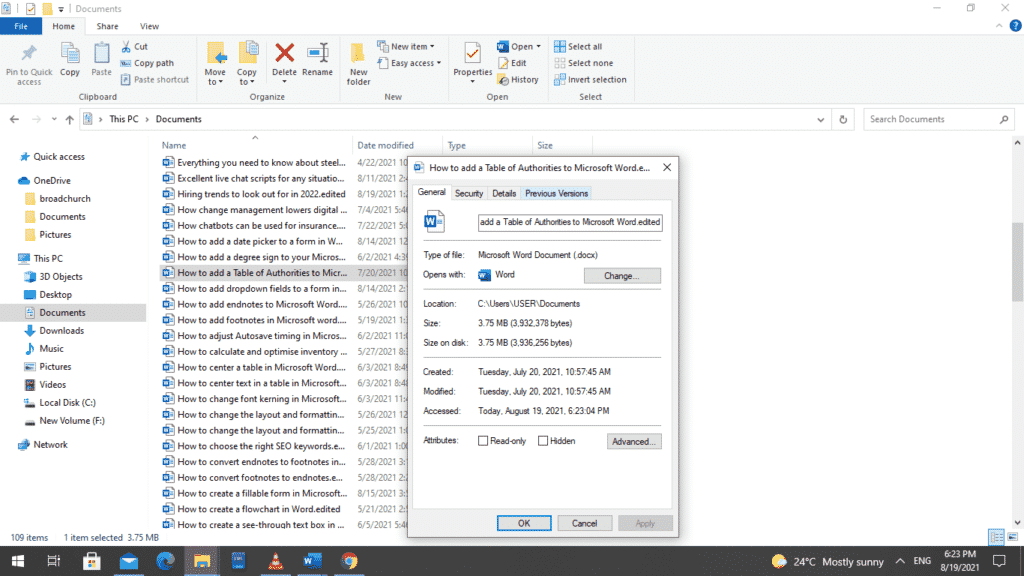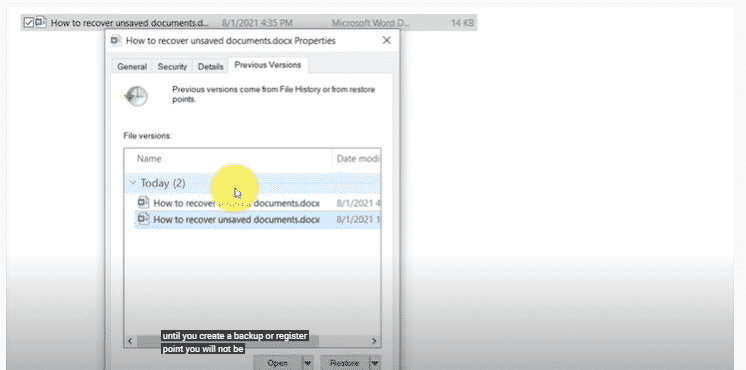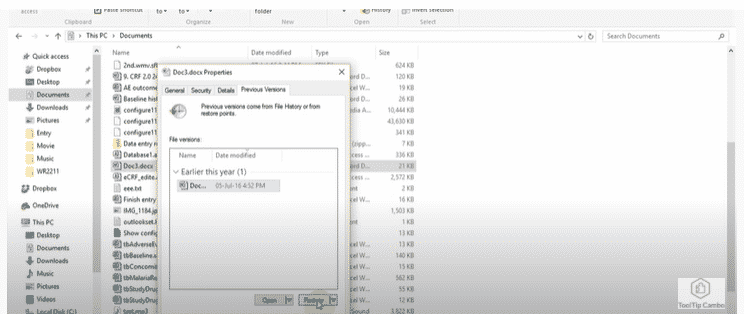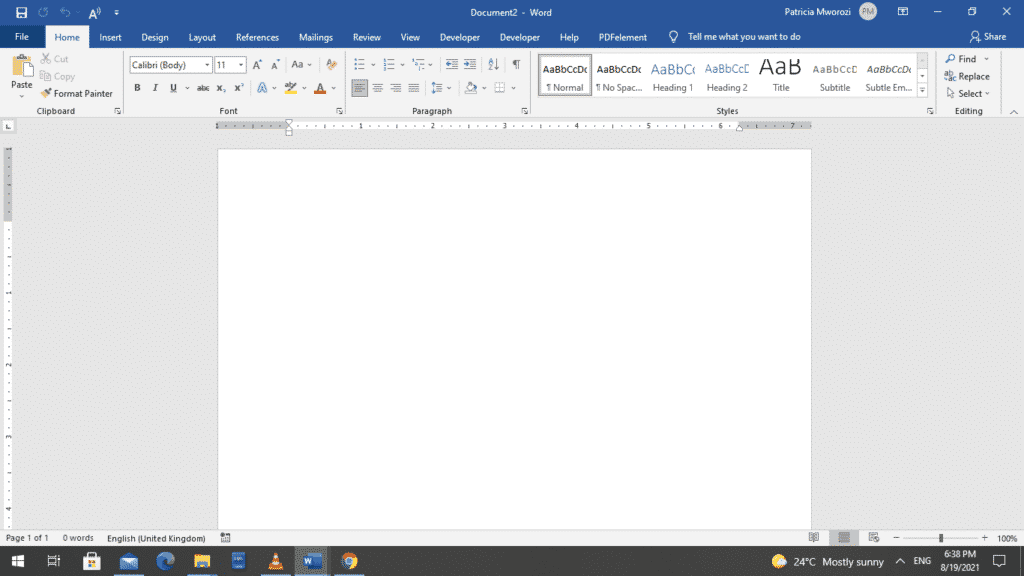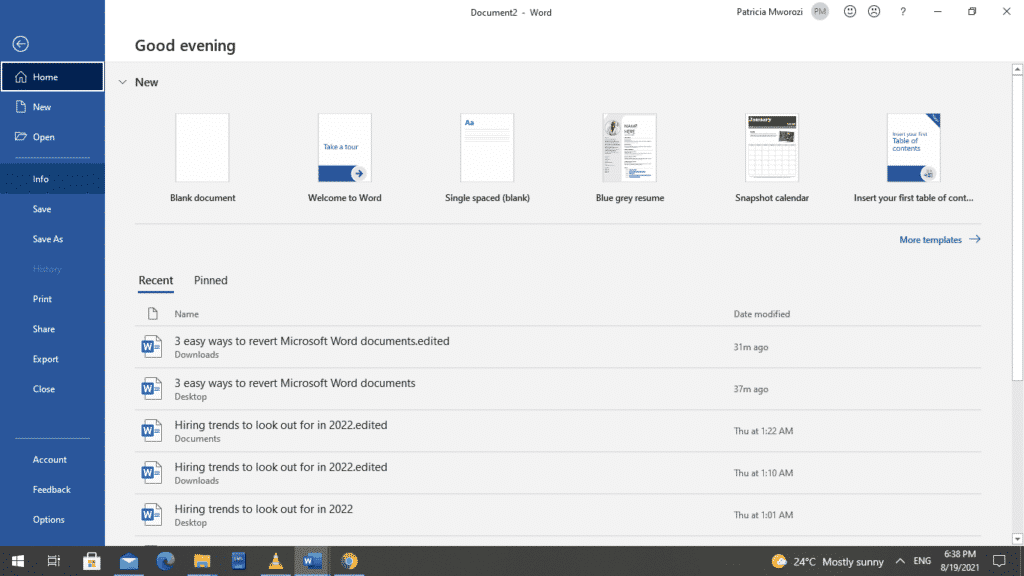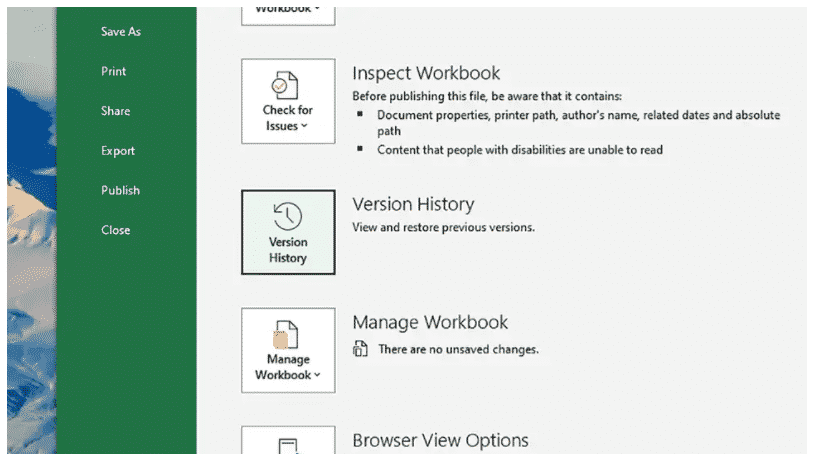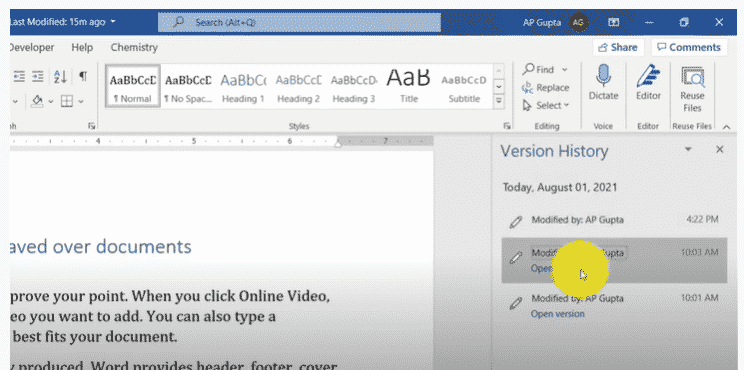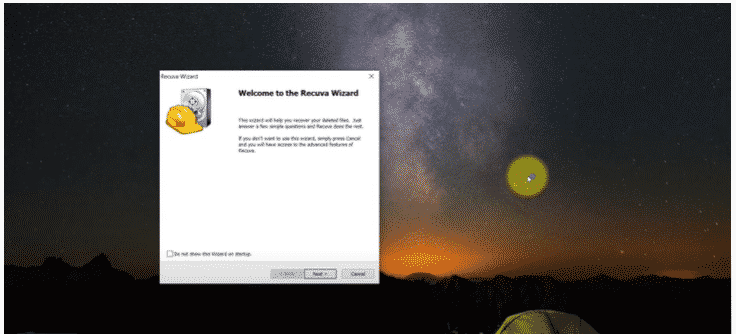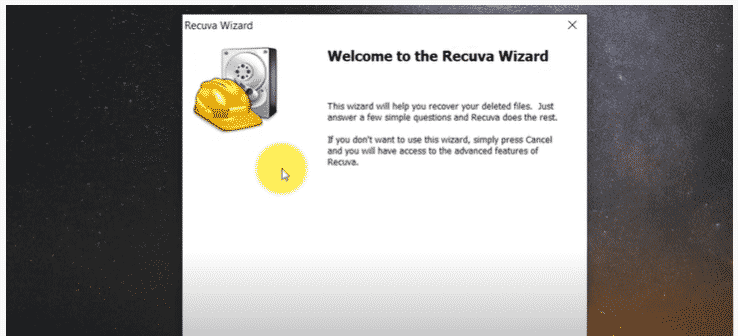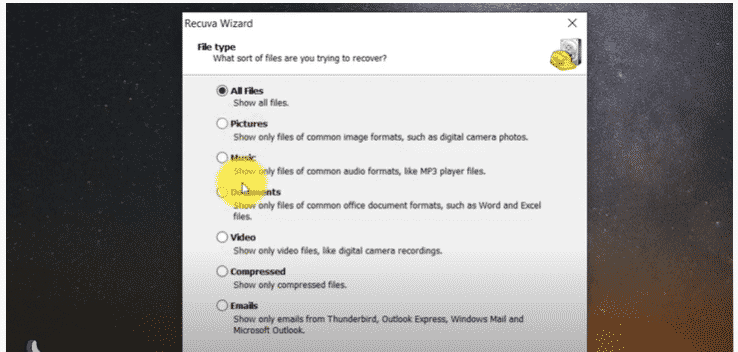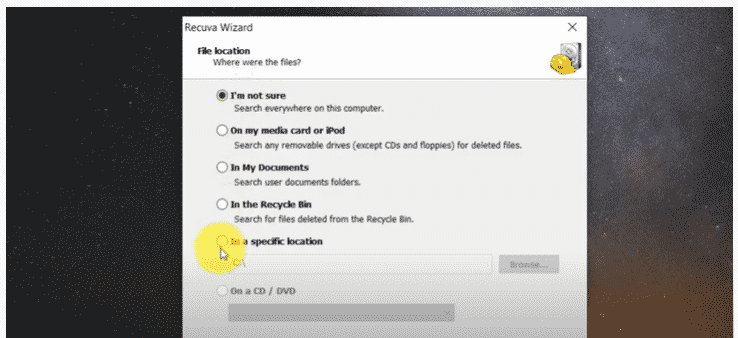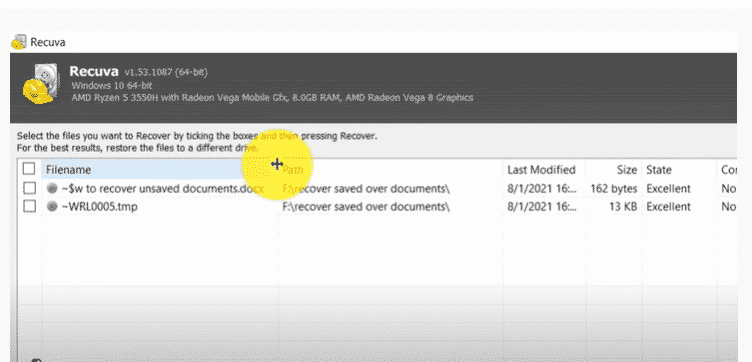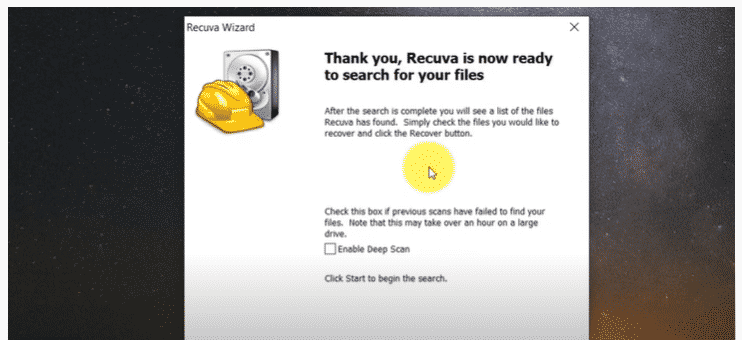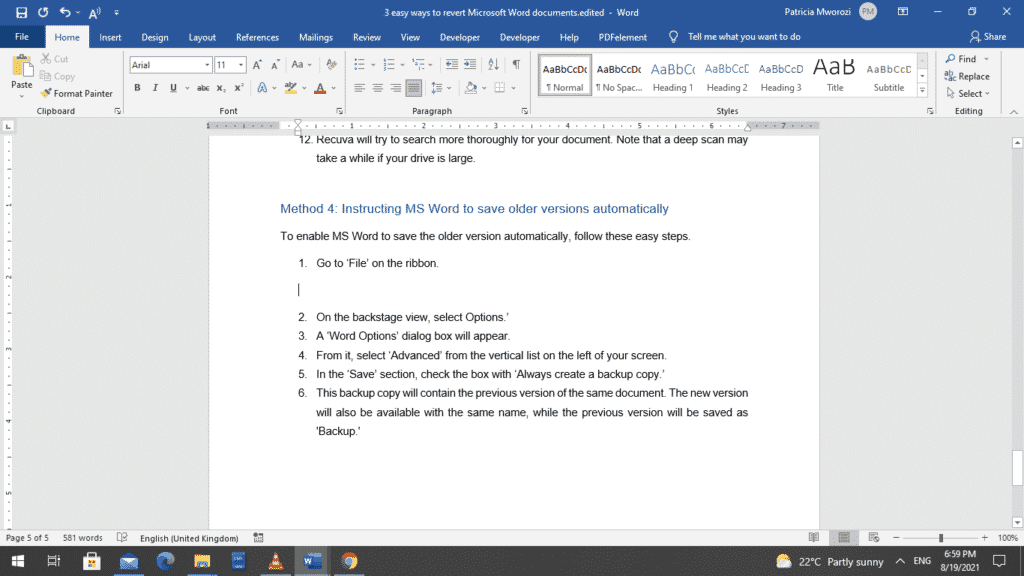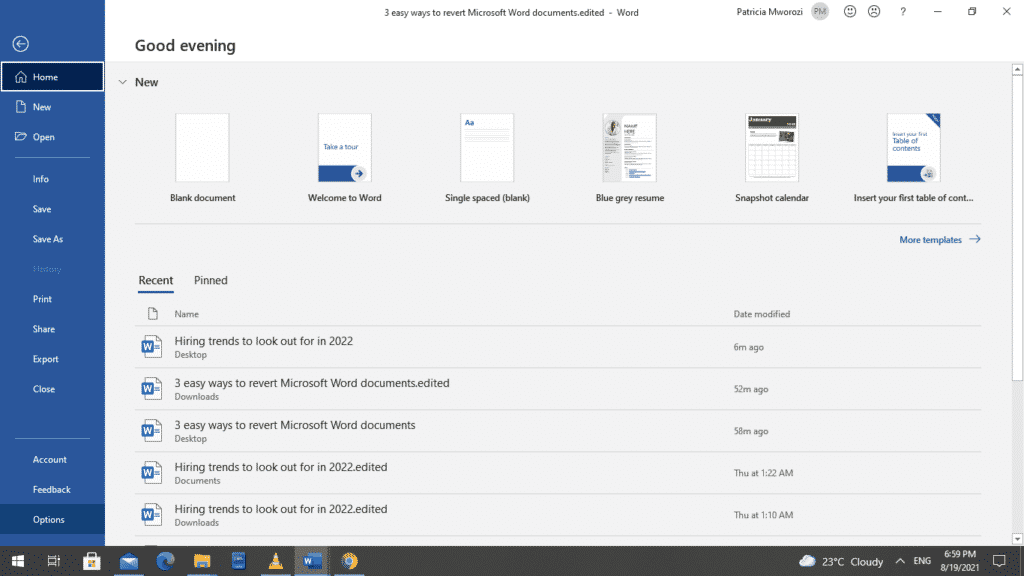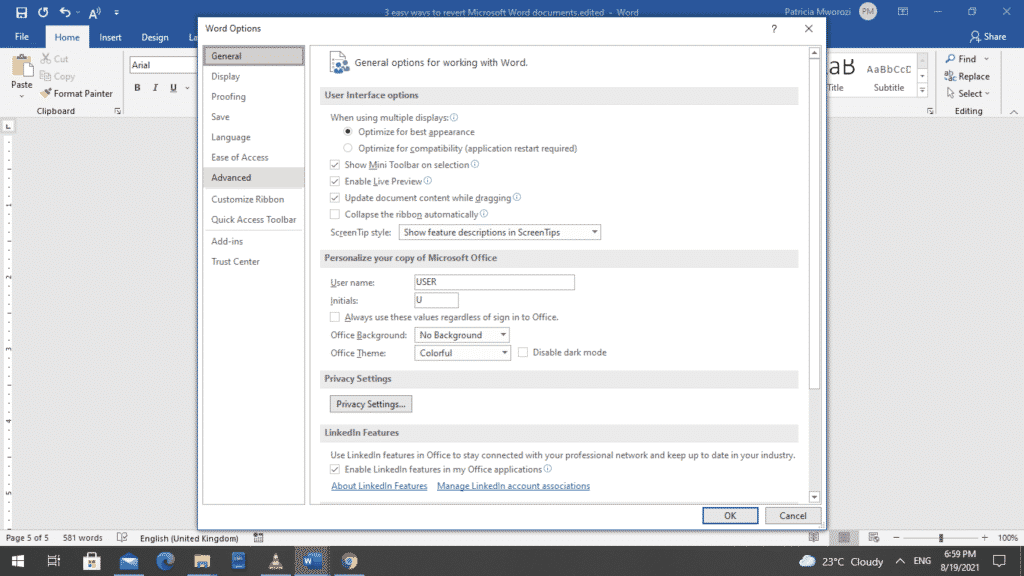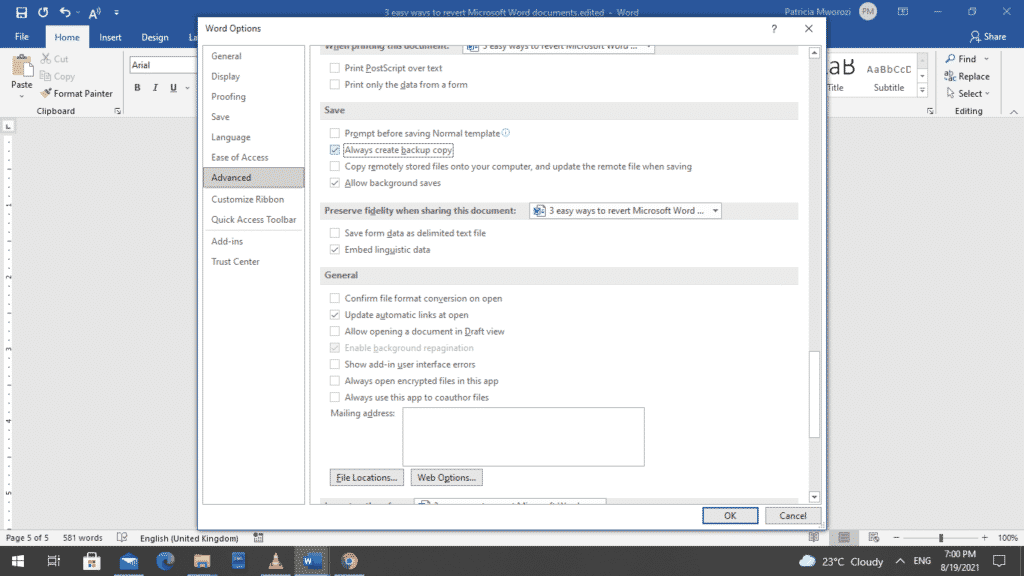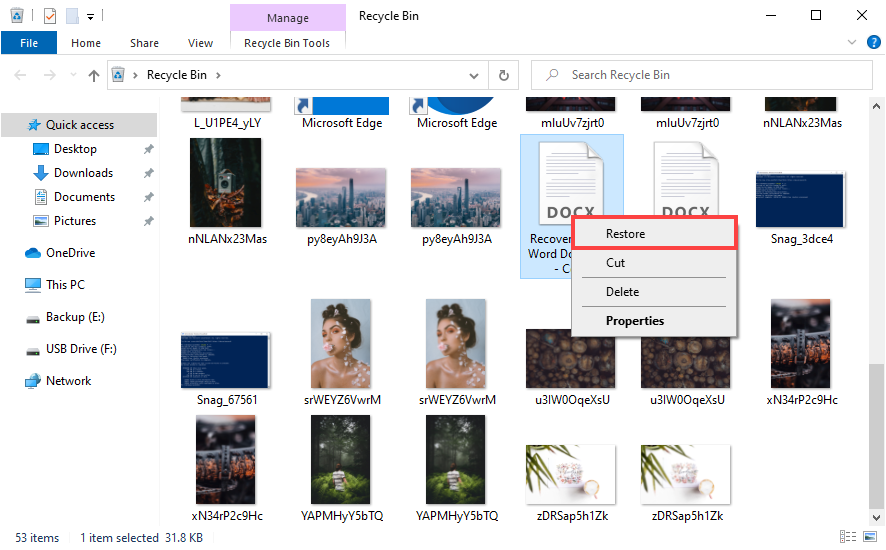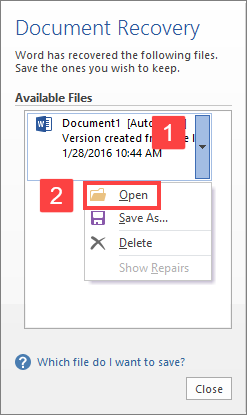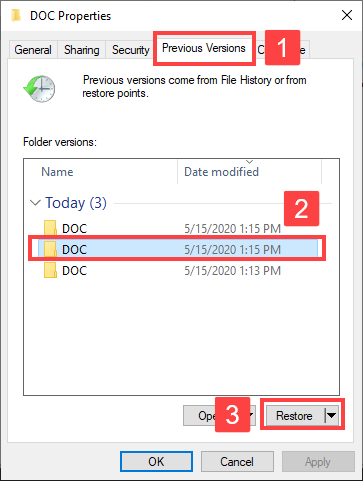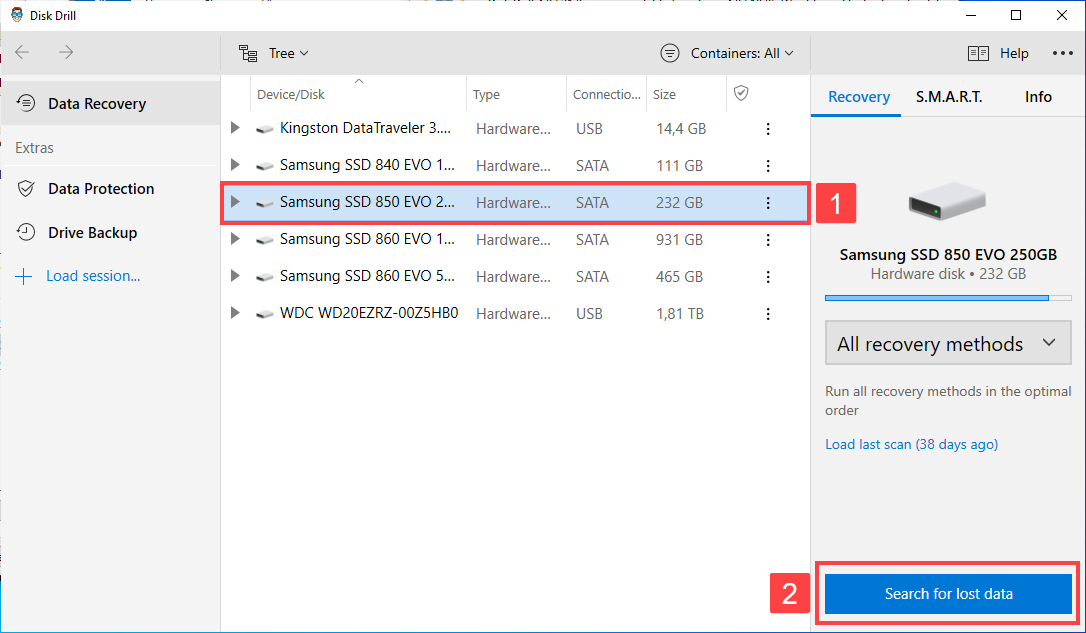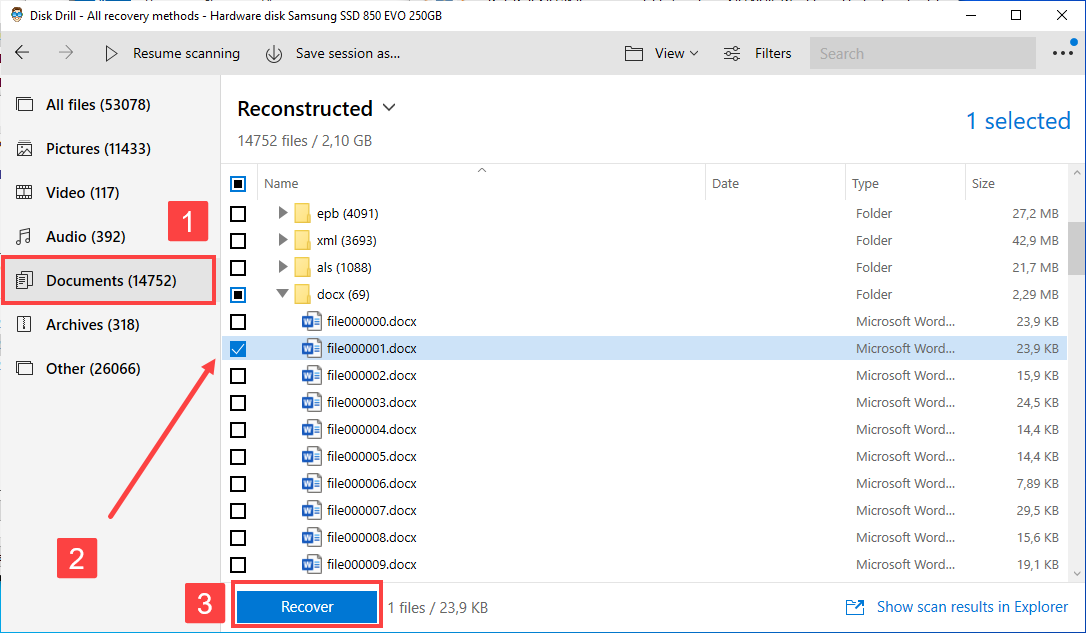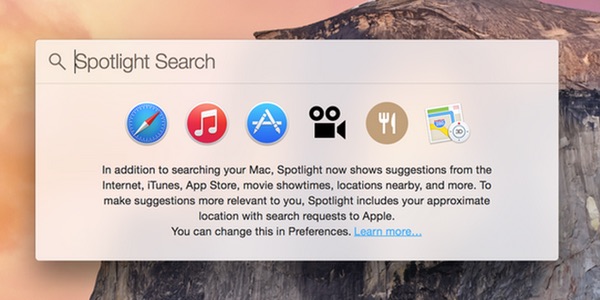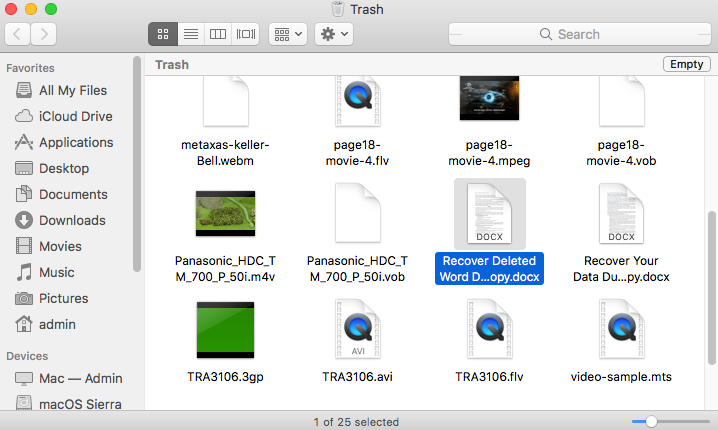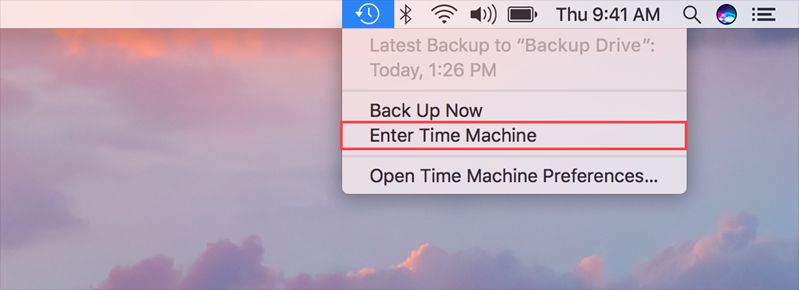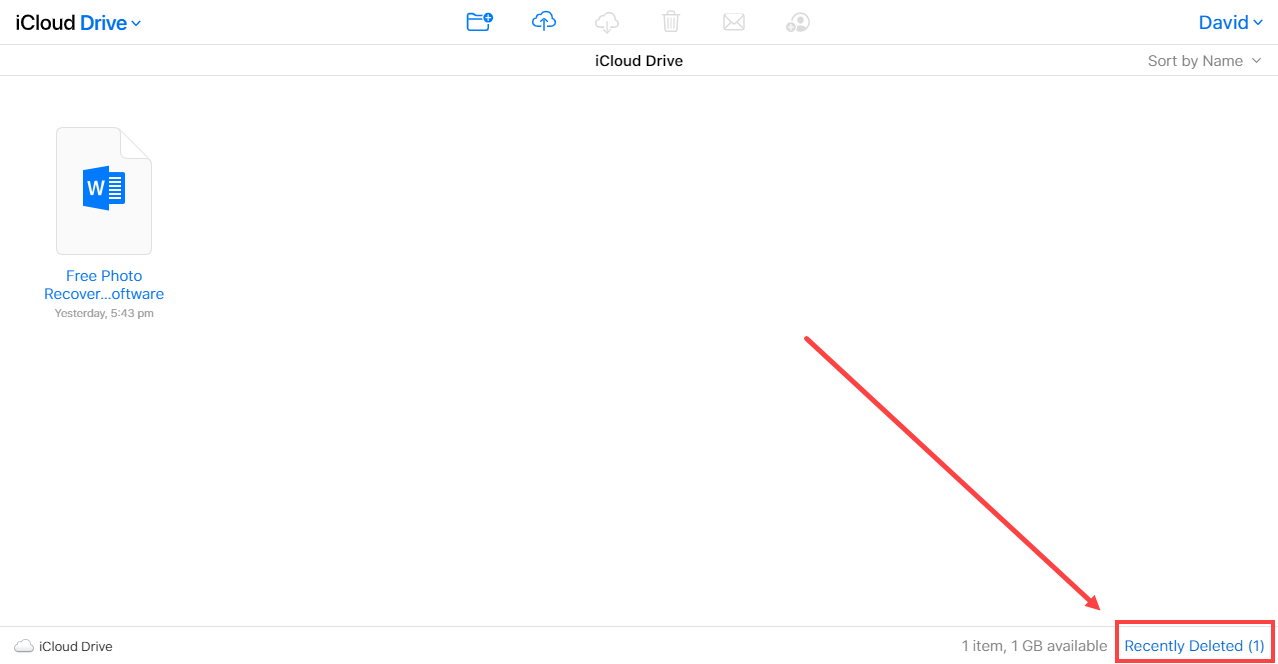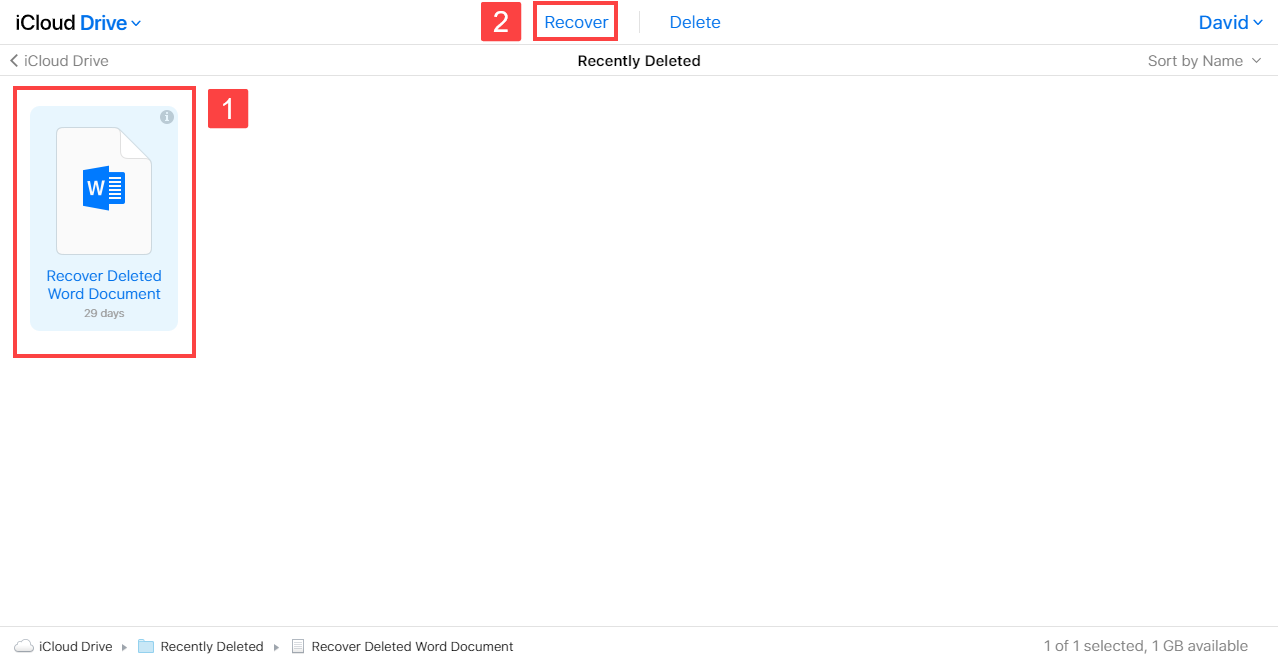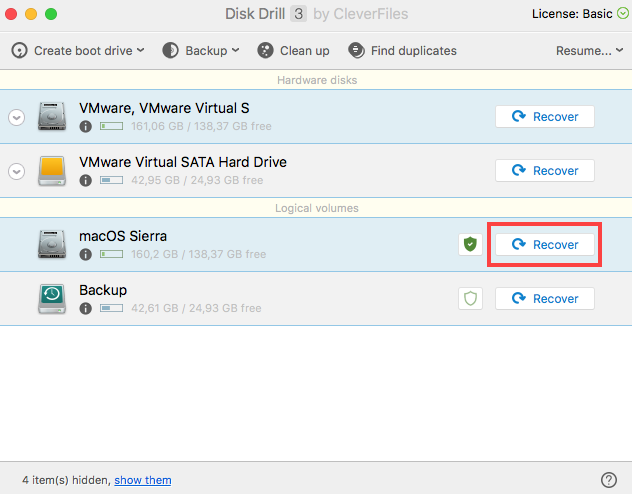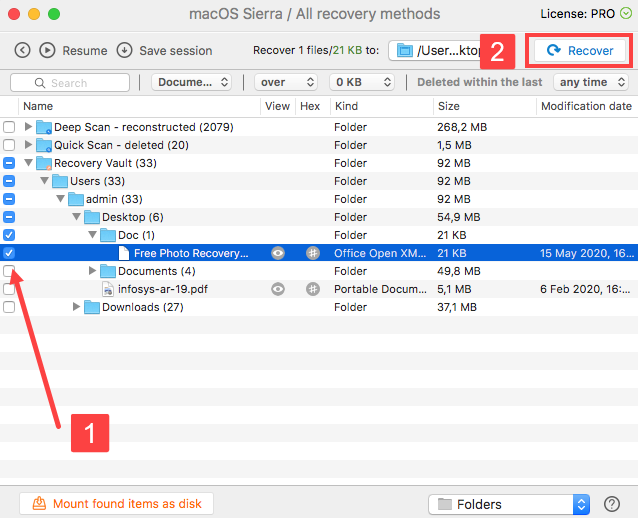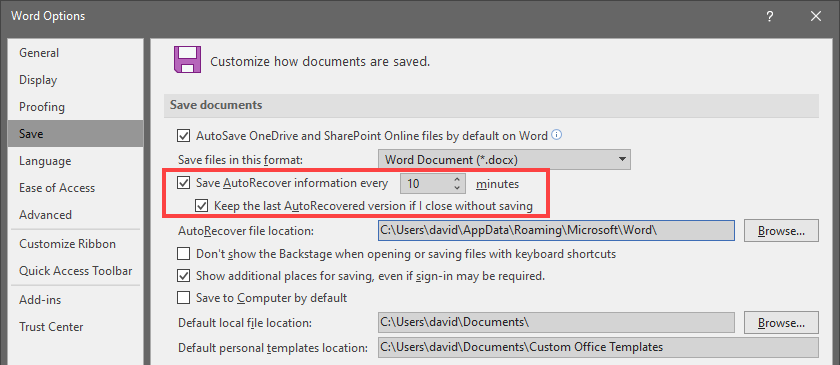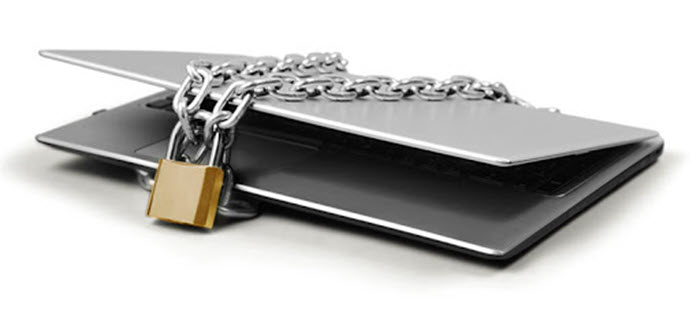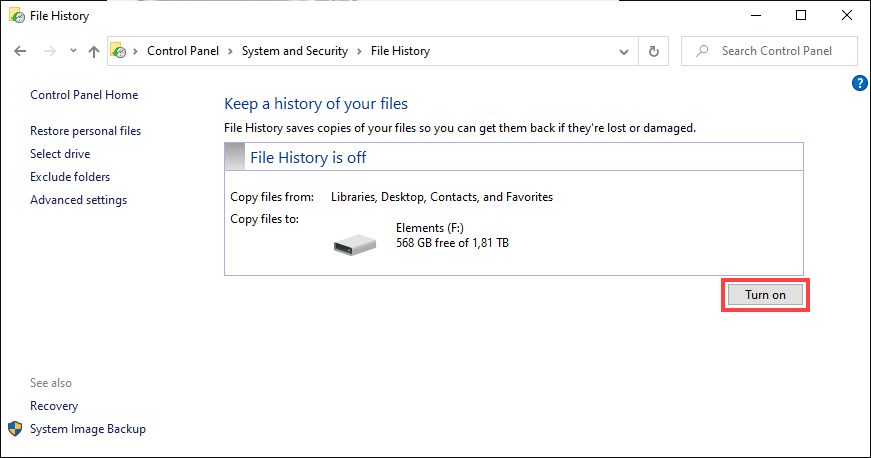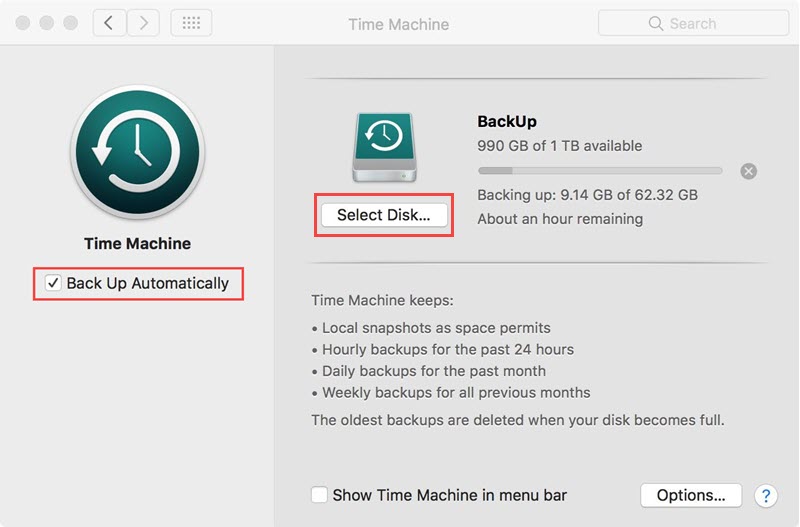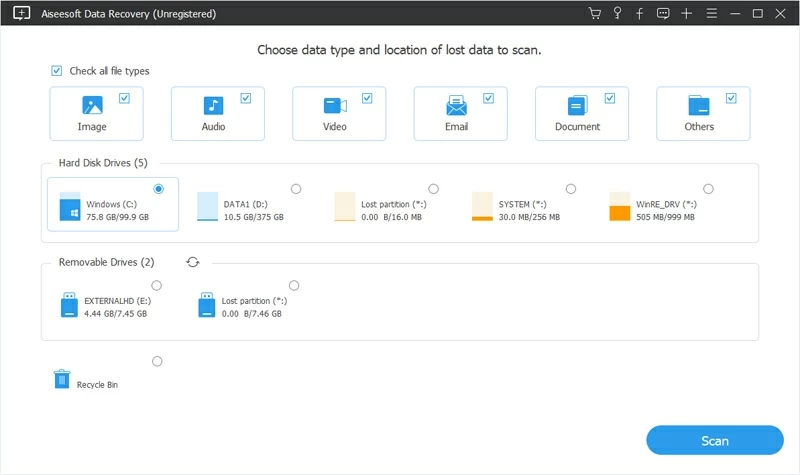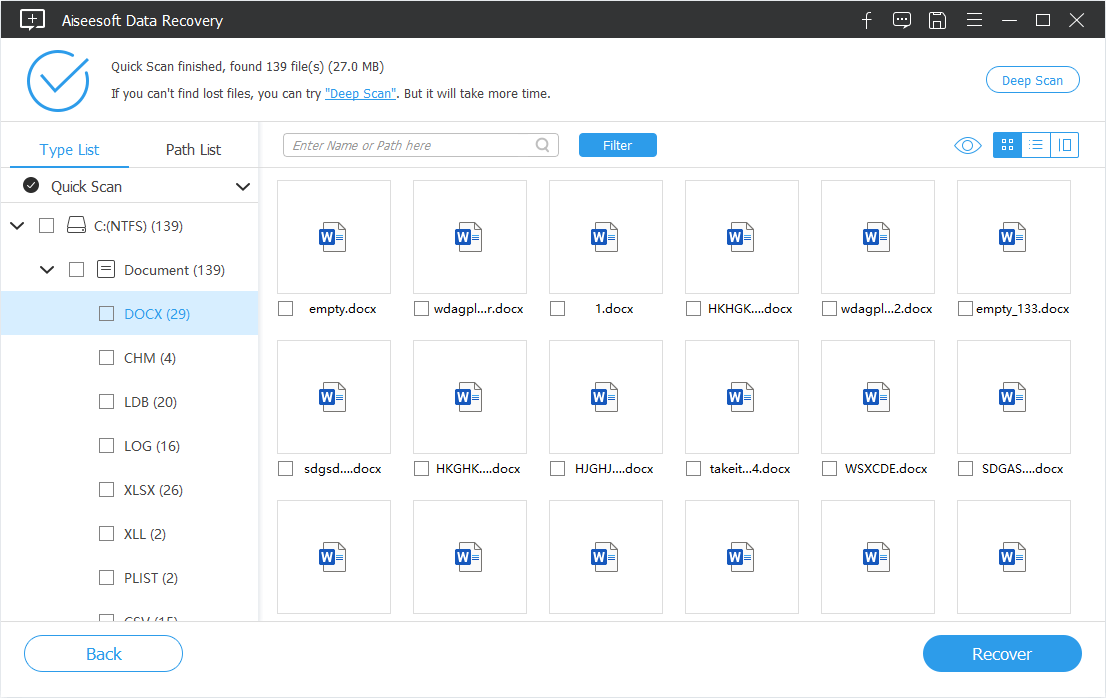Applied to: Microsoft Office Word 2020, 2019, 2016, 2013, 2010, 2007, and 2003
Closing the Word accidentally or a program/system crash may cause the unsaved Word document to disappear. Luckily, there is still a chance to recover unsaved Word documents in Windows 10/11 from Temporary Files, AutoRecover, or Word Document Recovery.
Besides, if your saved Word document gets deleted, you can restore deleted Word documents from the Recycle Bin or by using one of the best data recovery software.
| Workable Solutions | Step-by-step Troubleshooting |
|---|---|
| Fix 1. Recover unsaved Word from Temporary Files | Open Word program, click «File» > «Info» > «Manage Document» > «Recover Unsaved Documents»…Full steps |
| Fix 2. Restore unsaved Word documents from AutoRecover | Open Word > click «File» > «Options» > «Save» > copy AutoRecover file location path and paste it…Full steps |
| Fix 3. Retrieve unsaved Word with Document Recovery | When your system comes back online, reopen Word, click available files under Document Recovery…Full steps |
| Fix 4. Restore deleted Word from Recycle Bin | Go to the Recycle Bin. Check if the deleted word file is still there. If you don’t know the name…Full steps |
| Fix 5. Recover lost Word documents with Data Recovery Software | Choose the hard disk drive or a specific folder where the Word document was saved, click «Scan»…Full steps |
Have you accidentally closed your Word application without saving the document you had been working for a few hours? Have you lost the Word file unsaved due to a sudden program crash? Or mistakenly deleted some saved and essential Word document? If you are looking for an effective solution, you’ve come to the right place.
In this article, we will show you the most useful ways to recover unsaved Word documents. Furthermore, we also introduce you to a renowned office file recovery tool — EaseUS Data Recovery Wizard to help you restore deleted or permanently deleted Word documents in a few clicks. It is also competent to repair corrupted DOCX/DOC files as well as other documents.
Solution 1. Recover Unsaved Word Document from Temporary Files
Unsaved Word documents vanishing is a very unpleasant problem. Take it easy. There are three possible ways to find a Word document that is not saved. The following operations use Word 2016 edition as an example. The steps for Word 2013-2019 are similar.
Recovering unsaved Word documents requires you to turn on AutoSave in advance. If this feature is turned on, you can find the unsaved files through the following path:
C:UsersOwnerAppDataLocalMicrosoftOfficeUnsavedFiles
Or you can follow the steps given below to do it.
Step 1. In MS Word, click the «File» tab in the upper left.
Step 2. Click «Manage Document» and select «Recover Unsaved Documents» from the drop-down list.
Step 3. Check for your missing File in the dialog box. If it was a recent loss, it should appear.
Step 4. Open the recovered Word document and click the «Save As» button in the top banner.
Additional Help — How to Turn on AutoRecover
Many of us have experienced a situation where we have created a Word document and then accidentally closed it out without saving it. To avoid this kind of situation, you’d better enable AutoRecove.
Step 1. Open Word, go to «File» > «Options» > «Save».
Step 2. Tick the box of «Save AutoRecover information every * minutes» and «Keep the last autosaved version if I close without saving».
Step 3. Click «OK» to save the changes.
Excel, like Word, is an indispensable office software. If you lose an unsaved Excel document, you can use the methods we recommend to retrieve it.
Solution 2. How to Recover Unsaved Word Document from AutoRecover
Another way to get back an unsaved Word document is by using AutoRecover. AutoRecover file names end in the .asd file name extension. By default, Word searches for AutoRecover files every time that it starts, and then it displays any data found in the Document Recovery task pane. If the Document Recovery pane does not open, manually search for auto-recovered files. To do this, use one of the following procedures according to your Word version:
For Word 2010 — 2019:
Step 1. Open the Word program, and click «File» > «Options». In the left navigation pane, click «Save». Copy the AutoRecover file location path and paste it into File Explorer.
Tip: You can change the time of AutoSave interval in «Save AutoRecover information every xx minutes» and click OK.
Step 2. Go to the File Explorer, find the unsaved document, and copy the .asd file.
Step 3. Go to your Word app, click «File» > «Open» > «Recover Unsaved Documents» at the bottom.
Step 4. Paste the copied .asd file into the File Name box popping up. Open the Word file recover it.
If Word warns that «Word experienced an error…», repeat the steps and click «Open and Repair» at the open Unsaved Document window.
For Word 2002 — 2007:
| Versions | Steps |
|---|---|
| Word 2007 |
1. Click the Microsoft Office Button, and then click «Word Options» > «Save». 2. In the AutoRecover file location box, note the path, and then click «Cancel» and close Word. 3. Open the folder that you noted in step 2. 4. Look for the Word document that you are looking for ends in .asd (AutoRecover files). Then, double-click it to open and save it immediately. |
| Word 2003 & 2002 |
1. On the «Tools» menu, click «Options». 2. Click the File Locations tab, double-click AutoRecover files, note the path, click «Cancel», and then click «Close». Note: In the Modify Location dialog box, you may have to click the down arrow in the Folder name list to see the whole path to your AutoRecover files. Close Word. 3. Look for files whose names end in .asd (AutoRecover files) after locating the AutoRecover file location. 4. Double-click the Word document to open it. Next, save it immediately. |
Then, you can check the file content and save it as a new Word file at another secure location.
Solution 3. How to Restore Unsaved Word with Document Recovery
If your Word crashes or closes abruptly, it will automatically restore unsaved Word documents in most cases when it comes back online. You can find the unsaved Word documents on the left panel, under Document Recovery.
Solution 4. How to Recover Word Document from Recycle Bin
If you deleted a Word document without emptying the Recycle Bin, you could undelete the Word document with simple clicks.
Step 1. Go to the Recycle Bin. Check if the deleted word file is still there. If you don’t know the name, look for file types such as DOC, DOCX, DOT, etc.
Step 2. Select the Word file and click «Restore» to recover it.
If you have emptied the recycle bin after deleting files, the deleted Word file may have been permanently removed. If you are in the same case, follow the next solution to restore deleted Word documents with a data recovery program.
Solution 5. How to Recover a Word Document with Word File Recovery Software
If you have lost saved Word documents because of careless deletion, hard drive formatting, or system errors, the above ways won’t work. At this time, you have to resort to a professional hard drive recovery software — EaseUS Data Recovery Wizard.
With this capable tool, you can recover deleted files in Windows 11/10/8/7 in various formats, including documents, videos, audio files, emails, ZIP, and more.
Note: This solution can be only used to recover deleted or lost Word documents that were saved on your computer before.
Step 1. Choose the Word file location
Choose the drive or a specific folder and click the «Scan» button.
Step 2. Locate your Word files
The software will start immediately scanning all lost data on the selected drive. After the scan, click the «Documents» option in the left panel. Choose «Word» from the category bar. Then, click «Preview».
Step 3. Recover Word files
After previewing the lost Word files, select the desired Word files and click «Recover». Then, select a folder to store the Word files.
- Important
- We don’t recommend you try any data recovery software to recover unsaved Word documents. This type of program only helps you recover lost saved Word document due to accidental deletion, disk formatting, virus attack, partition loss, etc. Namely, there needs to be an original file saved before on your computer or storage media.
How to Recover Unsaved Word Document on Mac in 2 Ways
On Mac, AutoRecover is turned on by default. Take the two methods below to recover unsaved Word on Mac by using the AutoRecover function.
Solution 1. Restore Unsaved Word Document in Finder
Step 1. Start your Mac and open the Finder window.
Step 2. Search for AutoRecovery in the search bar. A list of files Word documents named «AutoRecovery save of» will appear.
Step 3. Find and open the Word document you want to recover.
Step 4. Click the «File» menu and choose «Save As». Rename the restored files and click the Save button.
Solution 2. Restore Unsaved Word Document with Terminal
The unsaved Word document can be recovered from the temporary folder by using Terminal.
Step 1. Open your Mac and go to «Applications» > «Utilities» > «Terminal».
Step 2. Type open $TMPDIR and find the TemporaryItems folder on the list.
Step 3. Find the file you need. Open and save it to recover unsaved Word documents.
Conclusion
In this tutorial, you can learn five ways to recover unsaved Word documents on Windows and Mac devices. With the help of EaseUS file recovery software, you can restore lost Word documents, whether they are deleted, encrypted by malware, or corrupted when it was saved on a faulty partition.
Hope these solutions can help you get back any lost Word documents.
Recover Unsaved Word Document Frequently Asked Questions
If you still have some Word recovery problems, you can read the following questions and answers to get more help.
How do I recover an unsaved Word document Windows 10?
Step 1. Click the «File tab», then choose «Info», then select «Manage Documents».
Step 2. Select «Recover Unsaved Documents» from the drop-down menu.
Step 3. Click «Open» when you have selected the document you want to recover.
Step 4. Click the «Save As» button and save your Word document.
How to recover unsaved Word document from USB?
If you have unsaved changes to a Word document that is stored on a USB drive, you can recover your work in two ways:
One way is to try opening the document from the Recent Documents list in Microsoft Word. To do this, open Word and click on the File menu. Then, click on Open and select Recent Documents. If your unsaved document is listed, you should be able to open it and recover your work.
Another way to recover an unsaved Word document from a USB drive is to use the Autosave feature. To do this, open the document that you were working on and look for the Autosave folder. If you find the file, you can recover your work by opening it in Word.
How to recover unsaved Word document 2016?
Try these methods to restore unsaved Word document in Word 2019, 2016, 2013, or 2010:
- Check your recently opened documents
- Try opening a temporary file
- Use the AutoRecover tool
Where are unsaved Word documents stored?
These Word files can be found via «File> Open» and click the «Recover Unsaved Documents» button at the very bottom of the Recent File List.
Download Article
A step-by-step guide to recover unsaved or damaged Word documents and restore previous versions
Download Article
- Recover Unsaved Documents (PC)
- Recover Damaged Documents (PC)
- Restore Previous Revisions (PC)
- Recover Unsaved Documents (Mac)
- Recover Damaged Documents (Mac)
- Restore Previous Revisions (Mac)
- Video
- Expert Q&A
- Tips
|
|
|
|
|
|
|
|
Did you close Microsoft Word without saving your document? You’re definitely not alone! Don’t panic—Microsoft Word has plenty of built-in options that can help you recover documents on your PC or Mac. This wikiHow teaches you how to restore unsaved or damaged Word documents, as well as how to go back to previous revisions. If you can’t recover your Word document using these tools, you’ll need to use data recovery software or restore from a backup to recover the document.
Things You Should Know
- If a document you need is damaged or corrupted, you can repair it using the Open and Repair feature in Word.
- If you save your documents to OneDrive or SharePoint, you can restore them to previous versions.
- If you forgot to save, find the file in /Preferences/AutoRecovery on a Mac or using Recover Unsaved Documents on a PC.
-
1
Open Microsoft Word. You’ll find it in the Windows Start menu.
- If Word crashed before you could save your document, you may see a panel called «Document Recover» in the left side menu upon opening the app. If this panel opens, click your unsaved file in the panel to open it, and then go to File > Save As to save it now. If this worked for you, there’s no need to continue with this method.
-
2
Click the File menu. It’s at the top-left corner of Word.
Advertisement
-
3
Click Info. It’s near the top of the left panel.
-
4
Click the Manage Document icon. It’s in the right panel and looks like a sheet of paper with a magnifying glass. A small menu will expand.
-
5
Click Recover Unsaved Documents on the menu. This opens the Unsaved Files folder, in which you’ll see a list of recently backed-up files that were automatically saved by Word but not yet officially saved by you.
-
6
Select the document and click Open. This opens the document in Word.
- If you didn’t see your document in the folder, it’s possible that you saved it to your Documents or Desktop folder.
-
7
Save your recovered document. So you don’t lose the document again, click the Save As button in the gray bar running across the top of the document and save it to a folder you’ll remember (such as Documents). If you don’t see this option, click File and select Save As.
Advertisement
-
1
Open Microsoft Word. If you can’t open your Word document because it’s damaged or corrupted, you can usually use the built-in repair tool to recover the document.[1]
You’ll find Word in your Windows Start menu. -
2
Click the File menu. It’s at the top-left corner.
-
3
Click Open. It’s in the left panel toward the top.
-
4
Click Browse. It’s at the bottom of the «Open» column in the center. This opens your computer’s file browser.
-
5
Navigate to the location of the damaged file. For example, if it’s in your Documents folder, navigate to that location.
-
6
Click the file once to select it. Don’t double-click it.
-
7
Click the down-arrow next to «Open.» A menu will expand.
-
8
Click Open and Repair. It’s toward the bottom of the menu. If the file is repairable, Word will repair it now.
- If the document isn’t repairable, you can usually extract the text without the formatting and images. To do this, select Recover Text from Any File from the «File Type» drop-down menu at the bottom-right corner and then click Open. At this point, you can either save the file by clicking File > Save As or paste it into a new file.
Advertisement
-
1
Open Microsoft Word. As long as you saved your document to your OneDrive or SharePoint in Microsoft 365, you can return to a previous version of the document. You’ll find Microsoft Word in your Windows Start menu.
-
2
Open the file you want to revert. To do this, click the File menu, select Open, navigate to and select the file, and then click Open.
-
3
Click the File menu. It’s at the top-left corner.
-
4
Open your version history. This lets you see different saved revisions of the document organized by date. The steps to do this are different by version:
- Word 365: Click Info in the left panel, and then select Version history (the clock icon) in the center panel.
- Word 2019 or 2016: Click History on the menu. If you don’t see it, it’s usually because you have a subscription to Microsoft 365. In this case, click Info in the left panel and then select Version history in the center panel.
-
5
Click the version you want. All versions now appear in the right panel under «Version history.» Clicking a version opens it in a separate Word window.
-
6
Click Restore to switch back to the selected version. This will undo any changes you’ve made since the revision you selected.
Advertisement
-
1
Open Finder
. It’s the two-toned smiley face icon on the left side of the Dock.
-
2
Click the Go menu. It’s in the menu bar that runs along the top of the screen. A menu will expand.
-
3
Click Go to Folder on the menu. It’s near the bottom of the menu.
-
4
Enter the path to the AutoRecovery folder. To do this, type or paste the following path into the box (replacing username with the username you use to log into your Mac): /Users/username/Library/Containers/com.Microsoft/Data/Library/Preferences/AutoRecovery
-
5
Click the Go button. This opens a folder that contains files that were automatically saved by Word.[2]
Files in this folder begin with the word «AutoRecover.»- You won’t see the file here if you selected Don’t Save when closing Word. Unfortunately, there’s no way to recover a document if you selected that option.
-
6
Double-click the file you want to recover. This should open it in Word.
- If it doesn’t open in Word, click the file once, press Return, and then type .doc at the end of the file name. Press Return again to save the new file name and follow any confirmation requests.
- If you are prompted to select an application, click Open With and choose Microsoft Word.
-
7
Press Command to save the file. This opens the Save As dialog window, which allows you to save the document with any file name (and to any location) you wish.
-
8
Select a saving location and click Save. If you don’t see a list of folders to save to, click the On My Mac button to browse for a folder on your Mac first.[3]
Advertisement
-
1
Open Microsoft Word on your Mac. If you can’t open your Word document in Word on your Mac because it’s damaged or corrupted, you can usually use the built-in recovery tool to recover the text within. You’ll find Word on your Launchpad and/or in the Applications folder.
-
2
Click the Word menu. It’s in the menu bar at the top of the screen.
-
3
Click Preferences on the menu. A dialog window will appear.
-
4
Click the General icon under «Authoring and Proofing Tools.» It’s near the top-left corner.
-
5
Check the box next to «Confirm file format conversation at Open.» It’s the first option.
-
6
Return to Word and click the File menu. It’s near the top-left corner of the screen.
-
7
Click Open on the menu. The option to open a file will appear.
-
8
Select Recover Text from the «Open» menu. It’s the menu near the bottom-right.
-
9
Select the document and click Open. This opens the text from the document, and hopefully some or all of the original formatting. You may lose some non-text details, but the text should be intact.
Advertisement
-
1
Open Microsoft Word on your Mac. If you accidentally saved changes to your Word document and want to revert to a previous version, you can do so easily in Word 365, 2019, or 2016 for Mac.[4]
You’ll find the program on the Launchpad and/or in the Applications folder.- This method only works for files saved to your OneDrive or SharePoint in Microsoft 365.
-
2
Open the file you want to revert. To do this, click the File menu, select Open, navigate to and select the file, and then click Open.
-
3
Browse the version history. This will let you view different saved revisions of the document organized by date. The steps to do this are different by version:
- Word 365: Click the click the name of the document in the title bar of Word (at the top), and then select Browse version history.
- Word 2019 & 2016: Click the File menu and select Browse Version History.
-
4
Click the version you want. The version list appears in a panel on the right side of Word. Clicking a document version opens it in a separate window.
-
5
Click Restore to switch back to the selected version. It’s at the top of the document. This will undo any changes you’ve made since the revision you selected.
Advertisement
Add New Question
-
Question
Can I retrieve a Word document that wasn’t saved?
Spike Baron
Network Engineer & Desktop Support
Spike Baron is the Owner of Spike’s Computer Repair based in Los Angeles, California. With over 25 years of working experience in the tech industry, Spike specializes in PC and Mac computer repair, used computer sales, virus removal, data recovery, and hardware and software upgrades. He has his CompTIA A+ certification for computer service technicians and is a Microsoft Certified Solutions Expert.
Network Engineer & Desktop Support
Expert Answer
If it isn’t in your recovered files folder and you aren’t in a corporate environment, it may be gone for good. If you are in a corporate setting, there’s going to be an exchange server somewhere and there will be a copy of your file on that.
-
Question
By mistake, I deleted the file data, after the delete I saved the file. How can I get the data back?
Go to the recycle bin icon on your desktop and right click it. A menu will show up, click on restore.
-
Question
How do I recover documents deleted from my PC that are permanently deleted and are not in my recycle bin?
This will be difficult, but you will need to look for a recovery program.
Ask a Question
200 characters left
Include your email address to get a message when this question is answered.
Submit
Advertisement
Video
-
You can increase the rate at which AutoRecover saves backups of your Word file by clicking File (or Word on Mac), clicking Options (or Preferences on Mac), clicking Save, and lowering the number next to the «Save AutoRecover information every» text line.[5]
-
If you deleted your Microsoft Word document, look for it in your PC’s Recycle Bin (sometimes called Trash) folder or your Mac’s Trash folder. If it’s not there, you may be able to restore it from a backup or use a data recovery tool.
Advertisement
About This Article
Article SummaryX
1. Open Word.
2. Go to File > Info > Manage Document.
3. Click Recover Unsaved Documents.
4. Select the document and click Open.
5. Click Save As to save the document.
Did this summary help you?
Thanks to all authors for creating a page that has been read 270,906 times.
Is this article up to date?
There are few experiences as universally familiar as losing a Word document. Everyone from high schoolers with Catcher in the Rye book reports to business executives with quarterly earnings knows the panic of their work disappearing when it’s just a few crossed-t’s away from being completed.
Fortunately, there are dependable ways to recover Word documents quickly and reliably. Whether your work was accidentally deleted, lost in a Microsoft Word crash, or simply disappeared, here’s a simple guide on how to recover unsaved Word documents.
And remember, if all else fails, installing a data recovery program like Acronis Revive or falling back on a recent file or system backup may help get your documents back (at least in a workably recent state).
Can I retrieve a Word document that wasn’t saved?
Whether you rely on Word for personal or business tasks, losing an unsaved document sucks.
If you don’t save your Word documents manually, your files can fall victim to an unexpected crash. If you’ve already experienced such loss, chances are you have a habit of pressing the «Save» button once (or twice) every so minutes. However, not many users have that habit.
Nonetheless, even if your system crashes with an unsaved document open, you can still recover it through several options.
You can recover unsaved files through Temporary Files, AutoRecover Files, Document Recovery, Recycle Bin, and Data Recovery solutions. We’ll explore all of those options more deeply a bit later in the article.
Does Word keep backup files?
Like most programs in its class, Microsoft Word has an in-built «auto-save» feature to automatically back up your progress every few minutes. The default auto-save folder to support this function is the AppData folder.
Examples of the file path to harvest copies of your work are:
C:UsersYour_UsernameAppDataLocalMicrosoftWord
Or
C:UsersYour_UsernameAppDataLocalTemp
Or
C:UsersYour_UsernameAppDataLocalMicrosoftOfficeUnsavedFiles
Word backup files carry the «.wbk» extension. If you haven’t disabled the backup option in Word, the program will make copies of your documents regularly.
To check if the backup option is active, go to «File» -> «Options» -> «Advanced»; then scroll down to the «Save» section -> select «Always create backup copy».
Can Word save to the Cloud?
Yes, it can. If you rely on the native Windows option, your documents will be uploaded to OneDrive.
Having your documents on the cloud enables easier sharing and improves collaboration. It also allows easier mobile access (from a PC, laptop, smartphone, or tablet) and enhances data protection.
To save files to the cloud, do the following:
1. Select the «File» menu and go for the «Save As» option;
2. Choose «OneDrive»;
3. Choose a descriptive file name and go for «Save».
You can save personal and payment information to OneDrive – Personal, with work-related files going to a company OneDrive. You can also pick an alternative location in the list or «Add a Place» of your preference.
If you’re using a third-party backup solution like Acronis Cyber Protect Home Office, you can upload backup files to the Acronis cloud. Storing your files with a dedicated cloud backup service provides improved cybersecurity via backup encryption, automated backups, and concrete data recovery processes.
How do I restore a permanently deleted file?
Multitasking on a device may lead to losing critical data. (files, documents, images, audio, video, etc.)
Sometimes, you can get distracted and accidentally delete files and folders. The most common reasons for an accidental deletion are:
· Accidentally emptying your Recycle Bin;
· Erasing documents via «Shift+Delete» keys;
· Deleting files via the command line;
· Deleting files with the «Do not move deleted files to Recycle Bin» option enabled
File deletion or corruption can also result from malware or virus infection on your device.
Fortunately, you can recover perma-deleted data and documents in several feasible ways. Not all of them are guaranteed to recover permanently deleted documents, but you may try all of them in order when needed.
You can still recover seemingly perma-deleted files due to how your hard drive operates. Every file on your device resides on a specific portion of the hard drive. When you delete a file from your hard drive, the drive removes the deleted data and marks the space it used to occupy as «free» for writing new data.
However, the file can be restored to its original location unless you write new data on the newly available space. Remember, you need to act quickly – even if you don’t save new data to the hard drive manually, your computer can initiate updates or save system data on the newly available space.
In such a scenario, recovering permanently deleted files becomes close to impossible.
How to recover deleted Word documents via Backup?
Windows 10 and 11 pack a new feature called Backup and Restore.
The option enables users to create backups of their data to restore them later if needed. To recover permanently deleted files via Backup and Restore, you’d need to have enabled the option on your Windows device.
Here’s how to do it:
· Connect the external media carrier holding the backup to your primary device
· Go to «Control Panel» -> select «System and Security» -> click «Backup and Restore (Windows 7)» option
· Once in the Backup and Restore menu, go for the «Restore my files» option -> a Restore wizard will pop up to start file recovery
· If you can’t find the «Restore my files» option, go for the «Select another backup to restore files» option. Again, a wizard will pop up to assist you with your recovery
Recovering via Backup and Restore will replace all data on your Windows device with backed-up data. So, to avoid further data loss, make sure the backup contains all your crucial data.
How to recover deleted Word documents via Previous Windows 10/11 version?
Windows 10 and 11 offer another convenient feature to restore permanently deleted files – the «File History» option. If you had enabled the option before deleting a document, you could use it to recover permanently deleted files without additional software.
To do so:
· Type «File History» in the Start menu or the Windows search bar
· Select «File History Settings»
· From the left panel on the pop-up window, choose «Restore personal files»
· Navigate the feature to the backup you wish to restore. You can do that via the left and right navigation buttons at the bottom of the window. While you switch between backups, you can preview backup dates and the folders within them
· Once you’ve located the specific backup storing the deleted documents, press the «Restore» button to recover the files to their original location
· If Windows suggests it already carries a file with the same name in the destination folder, go for the «Replace the file in the destination» option
Lastly, close the window and check if the recovery is successful.
How to recover deleted Word documents via Command Prompt?
Sometimes, files and folders can be hidden due to the «Hidden files and folders» feature in Windows. You can use the Command Prompt to try and recover them.
To do so:
· Type in «cmd» in the Search Bar on the Start menu
· Choose the «Run as administrator» option
· Type chkdsk *: /f in the Command Prompt. The * represents the letter of your hard drive, so replace it properly. Once you do, hit «Enter»
· Type ATTRIB -H -R -S /S /D D:*.* in the Command Prompt window. Here, replace the «D» with the letter corresponding to your hard drive. Once you do, hit «Enter» again
A recovery process should start immediately if you’ve followed the above steps successfully. Let it finish and check if your files have been restored.
How to recover deleted Word documents via System Restore?
If you’re running Windows 10 or 11, you can opt for a System Restore to recover permanently deleted files. As System Restore takes regular (automated) snapshots of your whole OS, you can revert any unwanted changes to your system by reverting it to a previous point in time.
However, you’d need to have activated the System Restore option beforehand.
To recover perma-deleted files via System Restore, you need to:
· Type in «create a restore point» in the Start menu or Windows search bar, and click «Enter»
· Select «System Restore»
· Go through potential system restore points in time and select the most appropriate to recover the deleted document; then, click «Next»
· Confirm the specific restore point and choose «Finish»
· Your PC or laptop will then restart to allow Windows to apply the changes
Although this option is convenient, you must remember that System Restore may affect recently installed drives, programs, and browser updates. As its primary goal is to repair your Windows environment, it will revert your device to an older version of itself. And that older version may not have some programs or apps installed or updated correctly.
Nonetheless, before the System Restore process starts, the feature will show you a window containing all programs that will be affected by it. This way, you can back up all potentially affected programs and files before you revert your system.
How to recover deleted Word documents via System Image Recovery?
System Image backup enables users to back up the entirety of a Windows 10 or 11 OS. However, the feature doesn’t allow single file and folder backup, so you wouldn’t be able to restore individual documents if needed.
Here, it’s either recover everything or don’t recover anything.
To recover documents via System Image Recovery, you need to:
· Type «settings» in the Start menu or Windows search bar, and click «Enter»
· Browse and select «Update & Security»
· From the options list on the left, go for «Recovery»
· Save the progress on any open documents or programs
· Then, go for the «Restart now» button (you can find it under «Advanced Startup»)
· Afterward, select “Troubleshoot” -> “Advanced Options” -> “See more recovery options” -> “System Image Recovery”
· Browse through the list of System Image backup files and select the one containing the deleted document, then click «Next»
· Choose additional restore options, then click «Next»
· Review all System Image properties and click on «Finish» to start the restoration process
Once the restoration is complete, the deleted document should be restored to its original location. (or an alternative location, if you’ve chosen so in the Restore settings)
How to recover deleted Word documents via a third-party Backup solution?
If you’re using a dedicated backup solution, you can initiate data recovery and restore permanently deleted files from your device.
For example, Acronis Backup and Recovery enables users to initiate efficient backups with over 20 supported platforms. Via the cloud, your data is securely stored in physical, cloud, virtual, and mobile environments.
If you need to recover files from Acronis backup, you can do it via the user-friendly interface.
To do so:
· Start Acronis Cyber Protect Home Office -> select «Backup» on the sidebar
· Select the backup containing the deleted documents from the backup list
· On the panel to the right, select «Recovery»
· The interface will present you with possible recovery models for the selected backup; depending on the backup’s type, you’d be able to choose from «Entire PC», «Disks», «Partitions», and «Files» options. To recover one or more documents, select «Files»
· Cyber Protect Home Office will display the backup’s properties and the data inside it. Then, select a specific version of the backup based on the date and time. The default option here is the latest backup
· The panel on the left lets you navigate the files you wish to restore in the panel on the right; after you select all needed documents, press «Next»
· Choose a recovery destination on your device to place the selected documents after restoration. Here, you have two options – recover the data to its original location or choose a new location via the «Browse» button
· You can customize the recovery settings for the current session via the «Recovery options» menu.
· Once you’re done with the settings, go for the «Recovery now» button.
You can terminate recovery via the «Cancel» button at any time. However, aborted recoveries can still cause changes in the selected destination folder, so only go for the option if absolutely necessary.
Tips on preventing your Word Files from being deleted or unsaved
How to recover Unsaved Word Document?
We rely heavily on autosaves, yet huge chunks of progress and entire versions of documents can be lost when we don’t manually save our work. The good news is, this problem is so common that Microsoft has made it easy to recover unsaved Word documents:
1. In MS Word, click the File Tab in the upper left.
2. Click Manage Document and select Recover Unsaved Documents from the drop-down list.
3. Check for your missing file in the dialog box. If it was a recent loss it should appear.
4. Open the recovered Word document and click the Save As button in the top banner.
Did You Know?
You can update the frequency with which Microsoft Word autosaves your documents. Click File > Options > Save and change the number of minutes to ensure you have a recoverable version of all your docs available in case you need to recover Word documents in the future.
Knowing how to recover deleted Word documents will make you seem like a wizard to many of the people in your office, but it’s not complicated at all. Whether you’re trying to recover MS Word documents that were accidentally deleted or compromised by malware, there are a few easy steps that could help you get it back.
1. On your desktop, open the Recycle Bin
2. Search for your file by document name, file type, or date deleted. If you find your missing file, note the Original Location. When you recover deleted Word documents, they automatically are restored to that location.
3. Restore the deleted document and either find it in its original location or click Quick Access to find it in the Recent Files list.
Did You Know?
When a file is deleted you’re actually just removing a marker that points to where the file was stored on the disc. The file actually exists on the disc until its space is overwritten by new information. Until that happens, you have a chance to recover Word documents.
How to recover Word Documents after a Crash?
Recovering Word documents that didn’t save doesn’t always stem from user errors. Whether your system unexpectedly went down or Microsoft Word crashed, Word documents can be recovered if you quickly search for the lost files before other files can take their disk space.
1. When your system comes back online, reopen Microsoft Word. The program automatically recovers unsaved Word documents in most cases.
2. If your document doesn’t appear in the AutoRecover list, click on File, then Options, then Save.
3. Copy the AutoRecover file location filepath and paste it into File Explorer.
4. Open the folder with your document’s name and copy the .asd file with the most recent modification date and time.
5. Return to MS Word, click File, then Open, then scroll to the bottom of the recent documents list and click Recover Unsaved Documents.
6. Paste the copied file into the folder that pops up and open the file to recover it.
Did You Know?
One of the most common reasons for Microsoft Word crashing is corrupt add-on or template. If your program consistently crashes, try running Word without any of these features loaded to see if that helps to improve reliability.
Can I recover a permanently deleted word doc without a backup?
Recovering a permanently deleted file via backup is the easiest and most reliable option. However, sometimes, users don’t have the chance to add a specific document to the backup. If they then accidentally delete the document, recovery gets a hell of a lot more complicated.
In such a scenario, you have two primary options.
The first one is to use data recovery software. Nowadays, many recovery tools claim to have an exceptionally high rate of recovering permanently deleted files. Usually, such solutions can recover over 1000 file types and formats and claim to restore data even from corrupted partitions or bad sectors on your hard drive.
They typically operate by collecting the lost data bit-by-bit until they can fully restore its original state. Such an approach can prove handy occasionally, but that depends heavily on the state of your computer’s hard drive.
If you lose a document due to a bad sector on your hard drive, the software may not be able to recover all of the document’s pieces successfully. This may lead to an altered version of the document or may not be able to restore it at all. In such a case, the document would be lost unless you have it stored in some form of backup.
This leads us to the second option.
Suppose a user perma-deletes a document by accident. In that case, most often, their reaction is to panic, especially if they don’t have the document stored in a backup outside their primary device.
However, we live in a technologically webbed world – anyone can send documents to multiple recipients via email, social media platforms, or free cloud services.
You can go through old emails, check DropBox or OneDrive shared storage, or go through your correspondence on Facebook and Instagram to find the deleted file. Nonetheless, if you’re 100% sure you haven’t sent the document to anyone, you can opt for the data recovery software option.
As we’ve mentioned, AutoSave is an in-built feature available in Word, Excel, and PowerPoint. (given you have a Microsoft 365 subscription)
AutoSave saves the progress on your Word files every few seconds unless you tell it otherwise. If you store your Word files on OneDrive, SharePoint, or OneDrive for Business, AutoSave is enabled by default.
To save a copy of your work before implementing any changes, it’s better to use the command «File -> Save a Copy» rather than «File -> Save As». That way, AutoSave will not overwrite the original document with the changes you make afterward.
If you skip that step and end up with an overwritten document, you can still restore the original via Version History. To do so:
· Open the Word file you wish to restore to a previous version
· At the top of the windows, click on the filename and go for «Version History»
· Review the dates and times of all versions to find the one you wish to restore -> click «Open Version»
· An additional window will pop up and show you the specific version of the document
· Once you’ve made sure this is the version you want to restore, click «Restore»
Whenever you open a Word document and make first changes, AutoSave will save those changes by adding a new file version to Version History. Afterward, AutoSave will regularly save changes to the document but only add new versions to Version History about every 10 minutes until you terminate the session. (ending the session means closing the Word document)
How do I get Microsoft Word to save AutoRecover versions every minute?
If you’re handling critical information via Word documents, saving a version of the file every 10 minutes may seem risky. However, Microsoft has thought of that – you can change the AutoRecover frequency to any number that suits you.
Here’s how to do it:
· Open Word and go to File -> Options -> Save
· You’ll see a settings section labeled «Save documents»
· Under the «Save documents» line, type your chosen number (of minutes) in the «Save AutoRecover information every (…)» box
· Once done, press «OK»
If you want to change the location for AutoRecover documents, go to:
· File -> Options -> Save
· Under the «Save documents» line, browse or type in the save path for saved documents in the «AutoRecover file location» field
· Once done, press «OK»
The AutoRecover settings window allows you to also:
· Disable AutoSave for OneDrive and SharePoint online files by default
· Change the cache location for AutoRecover files. The default should be «C:UsersYour_UsernameAppDataRoamingMicrosoft[OFFICEAPPFOLDER]
· Enable AutoSave on the computer by default
According to Microsoft, however, there is no option to use AutoSave locally in Office 2019 or 2021. Nonetheless, the AutoRecovery feature is still active to periodically save copies of your Word files to negate accidental data loss due to a crash.
Can I turn on AutoRecover in Word for Mac?
As with Windows, AutoRecover is available for Mac to protect the progress on your Word documents. Its default function here is the same – it makes a copy of your document every 10 minutes.
To enable AutoRecover and set the timeframe for making copies, you need to:
· With Word open on your Mac, go to the «Word» submenu on the top
· Choose «Preferences»
· Choose the «Save» option
· Choose «Save Auto-Recovery Information» and type in the duration you wish to set for AutoRecover copy creation
Microsoft advises users not to rely on AutoRecover as a substitute for manually saving their documents. (by clicking on the «Save» icon)
The most optimal way to preserve changes to your document is by manually saving it after every significant change. Nonetheless, it doesn’t hurt to set the AutoRecover timer to 5 minutes instead of 10 to guarantee you won’t lose progress due to a crash.
Keep in mind, when you manually save a document, its previous AutoRecover versions are removed.
On the other hand, AutoSave is a feature that saves your documents as you work on them. It works as if you’ve manually saved your progress. For Mac, AutoSave is available in Word, Excel, and PowerPoint for Mac and Microsoft 365 subscribers.
If you have AutoSave enabled, it’s less likely you’d need to rely on AutoRecover files.
Where is Autosave in Word located on Mac?
The AutoSave and AutoRecover features are linked in the Word menu. The path to enable AutoSave follows the same steps as with AutoRecover. However, you’ll have a few extra steps to complete before AutoSave is active for Word on your Mac.
Here’s how to do it:
· Open Word
· From the top menu, choose «Word» -> «Preferences»
· Click on the «Save» icon
· Tick the checkbox labeled «Turn on AutoSave by default»
· From the Word document, enable the AutoSave toggle to save your progress to the cloud (OneDrive or SharePoint)
· Explore more options from the AutoSave tab and select the «Automatically Save» option
· The AutoSave toggle will appear on the top side of the Word toolbar
· Name the document you’re working on and choose OneDrive or SharePoint as the storage location of the Word file
· Click «Save» to enable AutoSave to store changes in your desired location in real-time
· Your document will then be uploaded to the chosen location
·Once that’s done, AutoSave is on, and all changes you make to the document will be saved to OneDrive or SharePoint
Where can I find AutoSave Word documents on my computer?
If a power failure or a crash occurs, AutoRecover will typically recover the last version of your Word document automatically when you launch the app. Once AutoRecover opens the existing recovery file, it’s best to save it before editing or closing it immediately.
However, you may need to find AutoRecover files on your computer for other reasons. To do so:
· Switch to Finder
· Click «Go»
· Click «Go to Folder» (you can also use the SHIFT + COMMAND + G combo)
· Enter the specific folder path corresponding to Word, Excel, or PowerPoint
For Word:
/Users/Your_Username/Library/Containers/com.Microsoft/Data/Library/Preferences/AutoRecovery
For Excel:
/Users/Your_Username/Library/Containers/com.microsoft.Excel/Data/Library/Application Support/Microsoft
For PowerPoint: /Users/Your_Username/Library/Containers/com.Microsoft.Powerpoint/Data/Library/Preferences/AutoRecovery
Just a reminder: Replace «Your_Username» with your actual username.
As the AutoRecovery folder is hidden, typically, you won’t be able to find it by navigating in Finder. That’s why you need to use the «Go to Folder» feature and type in the full path to reach the folder.
Additionally, if you close a Word document and click «Don’t Save», the AutoRecover option won’t be active. The feature will delete the AutoRecover file because it assumes everything is okay and you wouldn’t need the AutoRecover file.
Can Microsoft Word recover previous versions of my document?
If you have turned the AutoRecover option on, it will automatically save versions of your documents regularly. (usually, at 10-minute intervals)
Once you have the AutoRecover files for your document, you can recover them depending on when you saved them.
There are two options: recover a saved file or an unsaved one.
If you have saved the document, you have to:
· Open the document you were working on
· Select “File” -> “Info”
· Find «Manage Documents» and choose the file labeled (when I closed without saving)
· A bar on the top of the file will appear; choose «Restore» to overwrite any previously saved versions
You can also compare AutoRecover versions by choosing «Compare» instead of «Restore».
If you haven’t saved the document, you have to:
· Open Word and go for “File” -> “Info” -> “Manage Document” -> “Recover Unsaved Documents”
· Select the specific file and click «Open»
· In the top file bar, choose «Save As» to save the document
If you have stored AutoRecover files in OneDrive or SharePoint in Microsoft 365, you can view all historical versions of a document.
To do so in Office 365:
· Open the file you want to inspect
· Select “File” -> “Info” -> “Version History”
· Browse through versions and select them to open them in a separate window
· If you want to restore the document to one of the previous versions, choose «Restore»
Keep in mind, if you operate via a Microsoft account, you’d be able to retrieve the last 25 versions of a document. If you sign in with a school or work account, the retrievable version volume will depend on your library configuration.
To view AutoRecover versions in Office 2019-2016:
· Open the document you want to inspect
· Click “File” -> “History”
· Choose a version to open in a separate window
If you can’t locate the «History» tab on the Word navigation pane, you may have a subscription version of Microsoft Office. If that’s the case, click the «Info» button and try accessing Version History from there.
To view AutoRecover versions on Mac:
· Open the document you want to view
· If you are using Microsoft 365 for Mac, choose the name of the document from the app’s title bar -> click «Browse Version History»
If you’re running Office 2016 or 2019 for Mac, go for «File» -> «Browse Version History»
· Browse AutoRecover versions and choose which ones to open in a separate window.
To view AutoRecover versions on the web:
· Open the document you want to view
· Go for “File” -> “Info” -> “Version History”
· Browse through AutoRecover versions and open the ones you want in a separate window
· When you find the version you’re looking for, choose «Restore»
If you use SharePoint in Microsoft 365 to handle documents, you can track AutoRecover versions, share them with others, and check recycle bin storage if you accidentally delete a file.
How to search for Word doc which I know I saved?
If you’re sure you have saved a Word document but haven’t been able to locate it, worry not. There are several ways to unfold saved documents, even when you’re computer is swamped with Word files.
You can search a file via the taskbar, the Documents tab, or File Explorer.
To find a Word document via the taskbar, type in the document’s name (if you remember it correctly) into the search box on the Windows taskbar. If you don’t know the full name of the document, you can use a keyword from it.
You can get results even if you remember a keyword from the text body of the document. (and not its name)
Once you type the name or keyword, Windows will show all matches on your device and OneDrive.
You can select the Documents tab if you wish to narrow your search. Once you do, your search results will only show documents.
Moreover, you can open File Explorer from a taskbar shortcut or right-click the Windows Start menu and choose File Explorer. Afterward, you can select a location on your hard drive from the left window pane.
You can then search or browse to find the document you need. You can search your entire device by selecting «This PC», or go for «Documents» and only look for files stored there.
How to search for Word backup files?
Although Word backup is seamless once set up for users, finding specific Word backups may be difficult without preparation. Luckily, you can learn how to pinpoint different Word backups below.
Check Word settings
If you remember how to open the AutoSave settings in Word, you can skip the next set of instructions. If not, you need to:
· Start Word -> click on «File»
· Choose «Options» and then click on «Save» on the left
· Ensure that the «Save AutoRecover information» option is enabled
Once you reach the settings window, go to the AutoRecover File Location field. Here, you can check the current AutoSave directory location.
By default, it would be «C:UsersYour_UsernameAppDataRoamingMicrosoftWord»
Once you locate the AutoSave directory location, you need to:
· Launch Word
· Navigate to the AutoSave directory
· Look for the version of the automatically saved backup and double-click it; the file will open in Word
As we’ve mentioned, the AutoSave directory may be a hidden folder on your computer, primarily if it resides in the AppData folder. However, you can bypass that by pasting the directory location in File Explorer’s address bar.
Nevertheless, you can navigate to the folder manually if you follow the path. Just make sure to reveal hidden items to be able to see the AppData folder. Once that’s done, you should easily find your way to the AutoSave directory.
Check the AppData folder
As we’ve said, the AppData folder is the default location for AutoSave backups. The pathing to the AutoSave directory can vary; the most common places to look are:
C:UsersYour_usernameAppDataLocalMicrosoftWord
and
C:UsersYour_usernameAppDataLocalTemp
Sometimes, the most recent AutoSave versions may use a different location. Most often, you’d be able to find them in
C:UsersYour_usernameAppDataLocalMicrosoftOfficeUnsavedFiles
As with previously shown paths, replace «Your_Username» with the username corresponding to your user account.
Regardless of which folder holds your Word backups, the AutoSave files have weird-looking names, especially for a casual user. They typically have a tilde before their name and the «.tmp» extension alongside a 4-digit number assigned to them.
Below are some examples of what Word backup files look like in different scenarios:
· ~wrdxxxx.tmp – such a name relates to a Word document within an AutoSave folder;
· ~wrfxxxx.tmp – such a name relates to a temporary document file;
· ~wraxxxx.tmp – such a name relates to an AutoRecovery file;
Complete AutoRecovery files won’t carry the «.tmp» extension but rather the «.wbk» extension. Once you locate them, you can double-click them to open the document in Word. An important note is always to save the file after you open it.
How to use the Recover unsaved documents option?
Sometimes, you’re sure you’ve saved a Word document, but your PC crashes, and you can’t locate the file afterward.
In such cases, you can still recover the document from the AutoSave location. To do so:
· Open Word and go to «File»
· Click «Recent», then select «Recover Unsaved Documents»
· You will be redirected to the AutoSave location folder; you can browse the documents here and find the one you’re looking for
Another path to reach the AutoSave folder is as follows:
“File” -> “Info” -> “Manage Versions” -> “Recover Unsaved Documents”
After you open the file, make sure to save it.
Check the Documents directory
To check the Documents directory, you should:
· Start Word
· Select «File», then choose «Open»
· Go for «Browse» and navigate to the directory you suspect holds the document
· Ensure to change the File Type of the folder from «All Word documents» to «All Files»
· If you’ve opened the correct folder, you should be able to see all corresponding backup files; you should easily spot the specific file as it is typically titled «Backup of (…)»
· Once you find the backup, you can open and save it
How to search your Windows temporary files manually?
In some instances, finding a backup file via traditional methods is more challenging, especially if you can’t find the AutoSave folder.
However, you can manually search for temporary files by tracking their extensions. Autosaved Word files usually carry the .asd or .wbk file extension.
To search for those, you should:
· Press the Windows Key + E on your keyboard; this will launch the File Explorer
· Once it’s up, click on the search bar on the top right
· Type in «.asd» or «.wbk» (without the quotes)
· Press «Enter»
· Windows will now search for all .asd and .wbk extensions
· Once the search is complete, you can browse through the matches and find the file you’re looking for
· Upon finding the specific file, right-click it and choose «Open File Location»; this will open the AutoSave directory location so that you can see all automatically saved backup files
If searching for .asd and .wbk extensions doesn’t bear any fruits, you can search for .tmp extensions. However, .tmp files aren’t necessarily all Word files. Many of them can support files from other applications, so you’d have to do some sorting.
How to recover Word Documents through Data Recovery Programs?
If none of these methods help you recover unsaved Word documents, your best bet is either backup software or data recovery software.
As always, the most secure and reliable way to recover data is with regular full image backups. Whether you use a Windows PC, a Mac, or a mobile device, having up-to-date backups ensure that you don’t lose your files – no matter what.
That said, if you didn’t have a backup plan in-place and active when you lost your Word document, you won’t have a backup to restore the file from.
In this case, personal cyber protection solutions like Acronis Cyber Protect Home Office are the best way to help you recover Word documents. Acronis Cyber Protect Home Office is an easy-to-use software solution that allows you to backup up the entire contents of your system so in the event of a disaster, you can locate a lost file and restore the MS Word document with just a few clicks.
Final Thought
Whether your Word doc was deleted, encrypted by malware or corrupted when it was saved on a faulty partition, you can recover it with Acronis Cyber Protect Home Office. When armed with regular backups, your docs can be recovered quickly and easily so you never have to worry about losing a Word doc or any other file ever again.
Let us say, for some reason, you have accidentally saved over a Word document, and you want to recover this version of a document.
There are different ways to revert to this older version.
Method 1: Windows Version History
- Go to the folder where your document is saved.
- When you find the document, right-click it.
- A dialog box will appear. Click ‘Properties.’
- Click the tab with ‘Previous Versions.’
- You will notice that there are two versions of this document.
You will also be able to see the timestamp of both documents.
Note: Windows will show you a previous version of a document only if you created a restore point or a backup of the drive where the file is located.
- You can select the version that you want and then click ‘Open’ or ‘Restore.’
- When you click ‘Restore,’ a dialog box will appear. This is to confirm that you know the current version will be removed if you choose to restore the previous one.
- Click ‘Restore’ to confirm.
- Click ‘OK.’
Method 2: MS Word Version History
Let us say you are working on a Word document saved on the Cloud or One Drive. In this case, Word preserves this document for free. To recover the older version of said document, follow these short and simple steps.
- Open the document.
- Go to ‘File’ on the ribbon.
- Select ‘Info’ on the backstage view.
- Click ‘Version History.’
- Doing this will take you back to the document you are working on.
- To the extreme right, you will notice a new section titled ‘Version History.’
You will see older versions of the document with different time stamps.
- Select the version you want to restore.
Method 3: File Recovery Software
There are paid and free versions of numerous software that can recover older or deleted files in Windows and Mac.
We are going to use Recuva.
- Once you have downloaded this software, open it.
- A recovery wizard will appear. Click ‘Next.’
- A ‘File Type’ dialog box will appear, asking you what type of file you are trying to recover.
- From the options available, select ‘All Files; which is the first option.
- Then, click ‘Next.’
- A ‘File location’ dialog box will appear. From it, select the location of your file from the list. If you are not sure, you have the option of checking ‘I’m not sure.’
- Recuva will generate a list of files it was able to find.
- If you can see your file from the list of options, select it and click ‘Recover.’
- However, if your file does not appear on the list, not all hope is lost.
- Check the box ‘Enable deep scan.’
- Then, click ‘Start.’
- Recuva will try to search more thoroughly for your document. Note that a deep scan may take a while if your drive is large.
Method 4: Instructing MS Word to save older versions automatically
To enable MS Word to save the older version automatically, follow these easy steps.
- Go to ‘File’ on the ribbon.
- On the backstage view, select Options.’
- A ‘Word Options’ dialog box will appear.
- From it, select ‘Advanced’ from the vertical list on the left of your screen.
- In the ‘Save’ section, check the box with ‘Always create a backup copy.’
- Click ‘OK.’
- This backup copy will contain the previous version of the same document. The new version will also be available with the same name, while the previous version will be saved as ‘Backup.’
Are you looking for a tool that enables you to work on a document with your colleagues simultaneously? A tool that lets you keep all versions of the same document?
Try Simul Docs. A collaborative tool that lets you smoothly work on documents with more than one person.
The first step is downloading Simul Docs then you can get started.
After writing your first draft in Microsoft Word, upload it to Simul Docs. This will automatically make it the first version. Now, another colleague can open it and make their edits. This will create another version different from the first.
Whenever another person opens a version and makes edits, a new version is created with the latest changes.
Suppose another co-worker is supposed to include their input, but they do not have Simul Docs. All you have to do is download the document or forward it by email. Alternatively, you can upload it to any storage software.
Once all the necessary edits have been made, you can save the final version containing all the modifications with one click.
Visit simuldocs.com and prepare your group projects without the usual hassle and bustle.
After hours of writing and editing, your computer decides to crash, or you accidentally delete the very same file you’ve been working on so hard. Sounds like a nightmare, right? Unfortunately, anyone can experience it, which is why we’ve put together this list of tried and tested ways to recover a deleted Word document on Windows and Mac.
Before We Start
If you’ve just lost a Word document, and you desperately want to get it back, the first thing you need to do is calm down and collect your thoughts.
Both your operating system and Word feature multiple data recovery mechanisms intended to protect users against accidental file deletion and loss of unsaved work, so there’s a good chance that you will be able to recover your Word document and save the day.
To increase the chance of successful Word document recovery, we recommend you limit the usage of your computer, especially when it comes to writing data to the storage device on which the lost Word document was located.
As a Windows user, you’ll probably recognize at least some methods to recover deleted Word documents described below, and you’ve probably already tried a few of them. Still, it’s a good idea to give them another try before you move on to some of the more complicated Word document recovery methods.
| Data Loss Scenario | Method of Recovery |
|---|---|
| I can’t find the document where I’d saved it. | Check If the Word Files Are Actually Deleted |
| I’ve recently accidentally deleted the document. | Recover Deleted Word Document from Recycle Bin (Before Empty) |
| I’ve just deleted the document and haven’t taken any actions yet. | Try the Undo Delete Feature |
| I’d made some changes in the document but didn’t save them. | Check Whether the File Was Autosaved |
| Word document was overwritten by the file with the same name. | Try to Restore Word Document from Previous Versions |
| I’ve lost my changes because of the program crash. | Restore Deleted Word Documents in OneDrive |
| Word document was deleted some time ago. | Use 3rd Party Recovery Software for Windows |
1. Check If the Word Files Are Actually Deleted
The Windows operating system has a powerful search feature capable of finding a Microsoft Word document located anywhere on your system. You should use this feature to verify that the missing document is really not present on your computer anymore and not just hiding in some unexpected folder.
To search for your MS Word document:
- Open the Start menu.
- Type the document name in the Start Search box.
- Click Documents.
- Look for the missing MS Word document.
No luck? In that case, there’s one more place where you should look for it.
2. Recover Deleted Word Document from Recycle Bin (Before Empty)
It’s easy to accidentally delete the wrong file in Windows—all it takes is an accidental press of the Delete key. Fortunately, accidentally deleted files are not immediately deleted. Instead, they go to the Recycle Bin, and you can easily recover them from there until you empty the Recycle Bin.
To recover a deleted Word document from Recycle Bin
- Open the Recycle Bin.
- Find the accidentally deleted Word document.
- Right-click on it and select the Restore option. Alternatively, you can simply drag the document to any folder you want.
If you haven’t found your Word document in the Recycle Bin, fear not because there are still several other ways to undelete Word documents that you can try.
3. Try the Undo Delete Feature
Just like most other operating systems, Windows has a global undo feature, which provides the possibility to undo any past action, including delete operations. You can think of the undo delete feature as a more convenient alternative to the Recycle Bin since it allows you to recover any file with a single shortcut.
To undelete your Word document using the undo delete feature:
- Open File Explorer.
- Go to the folder where the document was located.
- Press CTRL + Z on your keyboard.
The document should immediately appear in the folder. If it doesn’t, it’s time to take advantage of Word’s recovery features. You might also be interested in learning other Windows keyboard shortcuts.
4. Check Whether the File Was Autosaved
All recent versions of Microsoft Word feature multiple automatic backup mechanisms that allow users to easily recover their documents after their computer restarts unexpectedly or after a crash of Word itself.
Some of these automatic backup mechanisms must be first activated and configured to work properly, and we explain how near the end of this article.
4.1 Recover from Temporary Files
Microsoft Word keeps unsaved Word documents in a special folder dedicated to them. Normally, these temporary files are deleted when you save your document and close Word, but they often remain in the folder after a force quit on PC or after a computer shutdown caused by a sudden loss of power or hardware/software error.
To recover your Word document from temporary files:
- Open File Explorer.
- Copy the following address: C:Users%USERNAME%AppDataLocalMicrosoftOfficeUnsavedFiles
- Click the address bar and paste the address.
- Hit Enter on your keyboard.
- Look for ASD files and open them in Word to see if any of them is your Word document.
4.2 Check the AutoRecover Folder
To protect users from their own negligence, Word saves AutoRecover files every 10 minutes (you can change the frequency in Options), making it possible for users to recover a closed Word document that hasn’t been saved properly. You can find all AutoRecover files in the AutoRecover folder.
To check the AutoRecover folder:
- Open the File menu and select Options.
- Go to the Save section.
- Copy the address next to AutoRecover file location.
- Open File Explorer.
- Paste the address into the address bar and press Enter.
That’s how easy it is to check the AutoRecover folder manually. If you see any ASD files in it, you can open them with Word.
4.3 Recover with Document Recovery
When you open Word, it automatically searches for AutoRecover files and displays all that it finds in the Document Recovery pane, making it really simple to recover them.
To recover your Word document with Document Recovery:
- Launch Word.
- Look for your file in the Document Recovery pane on the left.
- Click the arrow next to the file.
- Select Open.
Now that we’ve exhausted all automatic backup mechanisms present in Microsoft Word, let’s take a closer look at one useful recovery feature of the Windows operating system.
5. Try to Restore Word Document from Previous Versions
You can tell Windows to keep previous versions of files on your system so that you can go back in time and restore an earlier version of a Word document or get back an overwritten Word document.
To restore an old version of a Word document from Previous Versions:
- Open File Explorer and navigate to the folder where the document was located.
- Right-click anywhere inside this folder and select Properties from the context menu.
- Select the Previous Versions tab and look for an earlier version of the document.
- Select the document and click Restore.
Since the Previous Versions feature requires a backup drive to be connected, many users never activate it. If that’s your case, try our next method.
6. Restore Deleted Word Documents in OneDrive
The most recent version of Microsoft Word can automatically save documents to your in real-time. After a crash, you can simply reopen your file, and every last word should be there. OneDrive also provides an extra layer of protection against accidental file deletion because it has its own Recycle Bin from which you can restore deleted files.
To restore deleted Word documents in OneDrive:
- Go to: https://onedrive.com/
- Sign in with your username and password.
- Select Recycle bin in the navigation pane.
- Select the document you want to recover and click Restore.
If none of the methods we’ve described so far helped, it’s time to analyze your hard drive using data recovery software.
7. Use 3rd Party Recovery Software for Windows
Have you tried all previously described methods to recover a deleted Word document but found no luck with any of them? There’s no reason to throw in the towel just yet because you can still use a third-party data recovery software application to scan your storage device at the file system level.
Disk Drill is a great choice for Windows users because it can recover hundreds of file formats (including all Microsoft Office formats, such as .DOC, .DOCX, .DOTX, .DOTM, .DOCB, .XLSX, or .PPTX) from both internet and external storage devices. You don’t need any expert knowledge to use Disk Drill because it makes the entire data recovery process straightforward and intuitive.
To recover your missing Word document using Disk Drill for Windows:
- Download Disk Drill from its website and install it.
- Launch Disk Drill and click the Search for lost data button next to your storage device.
- Locate the lost Word document.
- Click the Recover button to begin the recovery process.
As you can see, Disk Drill makes it very easy to recover permanently deleted Word documents. With the free version of Disk Drill for Windows, you can recover up to 500 MB, which should be more than enough for at least a hundred of Word documents.
Recover a Word Document on Mac
Mac users who’ve accidentally deleted the wrong document or closed Word without saving their work properly can choose from several different recovery methods, some of which are probably less obvious than others.
| Data Loss Scenario | Method of Recovery |
|---|---|
| Word document is lost somewhere on my Mac. | Check If the Document Is Actually Deleted |
| I’ve recently deleted the document. | Check the Trash Folder |
| I would like to restore an unsaved Word document. | Recover Word Files from Temporary Folder/AutoSave |
| Word document was overwritten and I have it on the backup. | Recover Word Files from a Time Machine Backup |
| I want to restore overwritten Word document. | Recover Word Documents from iCloud |
| I want to recover the document and I don’t have any backups of it. | Use 3rd Party Recovery Software for Mac |
1. Check If the Document Is Actually Deleted
Before you try a bunch of recovery methods to get back your lost Word document, you should check if it’s actually deleted and not just hiding somewhere on your disk.
To search for your document:
- Press Command – Space bar to open Spotlight.
- Type the name of the document.
Alternatively, you can use the search bar in Finder, but it’s unlikely that it will retrieve different results. If you have time, consider learning other Mac keyboard shortcuts since they may come in handy when trying other recovery methods.
2. Check the Trash Folder
When you delete a file on a Mac, it goes to the Trash folder, where it stays until you empty it, or until the file is automatically removed from it after 30 days. Before that happens, you can easily recover it.
To recover a Word document from Trash:
- Open Trash by clicking on its icon, located on the right side or bottom of the Dock.
- Go through Trash and look for the document you want to recover.
- Select the document and drag it to another folder or your desktop.
Haven’t found the document in Trash? Then, you need to look for it in folders used by Word for temporary recovery files.
3. Recover Word Files from Temporary Folder/AutoSave
As we’ve described in the section dealing with the recovery of Word documents on Windows, Word features multiple automatic backup mechanisms that can help you recover your Word document without using any special tools.
Since the automatic backup mechanisms are more or less identical in the Windows and Mac version of Word, you can follow the step-by-step instructions in the Windows section and make small adjustments when you see fit, such as using Finder instead of File Explorer.
Pro tip: Microsoft provides a detailed guide on how to recover a lost Word document on its website, so don’t hesitate to check it out.
4. Recover Word Files from a Time Machine Backup
Unless you’re using a very old Mac that you haven’t updated in ages, you have access to a handy backup tool called Time Machine. Provided you’ve activated it in the past, you can now use it to recover your deleted or lost Word files or a previous version of a Word document that you’ve overwritten or somehow messed up.
To recover a Word file from a Time Machine backup:
- Connect your Time Machine backup disk if it’s not already connected to your Mac.
- Open the folder that contained the deleted Word documents.
- Click the Time Machine icon located in the Menu Bar and choose Enter Time Machine.
- Locate the documents you want to recover using the timeline on the right edge of the screen.
- Click Restore to restore the selected document.
No Time Machine backup available? That’s not the end of the world because there are other backup solutions that you might be able to use.
5. Recover Word Documents from iCloud
Apple offers its own cloud storage solution, called iCloud, and many Mac users use it to back up their files, including Word documents. If you’re among them, you’re in luck because iCloud gives its users 30 days to recover deleted files.
To recover your Word documents from iCloud:
- Go to: https://www.icloud.com/
- Sign in with your login and password.
- Go to your iCloud Drive.
- Click Recently Deleted in the bottom-right corner.
- Select your document and click Restore.
If you don’t use iCloud and can’t recover your Word document from it, then you’re only remaining option is a third-party data recovery software solution.
6. Use 3rd Party Recovery Software for Mac
Third-party recovery software like Disk Drill can save the day by scouring your drive and locating any recoverable Word documents. The recovery process is mostly automated, so you don’t need to worry about how Disk Drill’s advanced recovery algorithms work—all you need to do is enjoy the results.
To recover your lost Word document with Disk Drill for Mac:
- Download and install Disk Drill for Mac.
- Launch the application and click the Recover button next to the drive on which your document was stored prior to deletion.
- Wait until Disk Drill finishes analyzing the drive.
- Look inside the recovery folders and locate the deleted document.
- Select the document you want to recover and click the Recover button.
The free version of Disk Drill for Mac can preview all recoverable files, but you need to purchase a license to actually recover them.
How to Enable AutoRecover Function in MS Word?
The AutoRecover function acts as a safeguard, protecting your unsaved Word documents from crashes, power outages, and user errors. With the function turned on, you can easily recover your documents after a crash from the Document Recovery task pane, which automatically appears the next time you launch Word.
To enable the AutoRecover function in Word:
- Launch Word and go to File > Options > Save.
- Select the Save AutoRecover information every x minutes box.
- Select the Keep the last autorecovered version if I close without saving box.
You can change how often Word saves AutoRecover information using the small arrows next to the number in the Save AutoRecover information every x minutes box. The default value is 10 minutes, and you can decrease it to as little as 1 minute for extra safety or increase it to make Word perform slightly faster.
Why Protect Word Documents with Backups?
Even though there are several different solutions on how to recover unsaved or deleted Word documents, none of them is 100% reliable. If you have Word documents that you absolutely can’t afford to lose, you need to frequently back them up.
There are multiple backup approaches that you can choose from:
- Manual backups: By far the most time-consuming and error-prone backup approach, manual backups are easy to get started with, but they can just as easily end in a disaster. We recommend them only as a secondary backup strategy.
- Automatic local backups: You can choose from multiple backup solutions to automatically create local backups of your Word documents. Both Windows and macOS come with reliable backup tools (called File History and Time Machine, respectively), so there’s no reason to spend money on a third-party solution unless it can do something extra.
- Cloud backups: In recent years, cloud backups have emerged as a popular backup strategy, allowing you to access your files from anywhere. Word documents are easy to back up to the cloud because of their small file sizes, and many cloud backup solutions, such as OneDrive and Google Drive, even support online Word document editing.
Each of these three backup approaches has certain pros and cons, which is why it’s typically a good idea to combine at least two of them. If you haven’t yet implemented any backup strategy, we highly recommend you start by activating the native backup feature of your operating system.
To activate File History in Windows:
- Open the classic Control Panel.
- Go to System and Security and then File History.
- Click Turn on to enable the File History feature.
To activate Time Machine in macOS:
- Open the Apple menu and select System Preferences.
- Choose Time Machine.
- Click Select Backup Disk and add a suitable disk.
- Check the Back Up Automatically box and close the Time Machine window.
FAQ
To recover an unsaved Word document in MS Office 2007:
- Launch Word and click the Microsoft Office button.
- Select Options and click Save in the navigation pane.
- Copy the path in the AutoRecover file location box.
- Launch File Explorer and paste the copied path and press Enter.
- Look for files whose names end in .asd (AutoRecover files).
- Locate the unsaved document and open it just like you would a regular Word document.
To recover a Word document that was overwritten:
- Open File Explorer and navigate to the folder where the document was located.
- Right-click anywhere inside this folder and select Properties from the context menu.
- Select the Previous Versions tab and look for an earlier version of the document.
- Select the document and click Restore.
Yes, it is often possible to recover a Word document that wasn’t saved properly because Word automatically saved the so-called AutoRecover files and searches for them when it starts. It then displays everything it finds in the Document Recovery task pane, and all you need to do is select your document and open it.
To recover a corrupted Word document:
- Launch Word and click File > Open > Browse.
- Navigate to the location with the corrupted document.
- Select the document you want to recover and click the arrow next to Open.
- Click Open and Repair.
Blake Sullivan Updated on Jun 23, 2022 4:25 PM
How to recover an unsaved Word 2007 file in Windows 7? My computer shuts down suddenly and the data with the Word document is missing when I relaunch the tool. Is it complete deleted or just saved somewhere I can’t find?
Microsoft Word (MS Word) documents can be information-enriched Word files fulfilled with formatted texts, images, charts, page data or more saved in .doc, .docx, .dotx or other Word file formats. With all that crucial data, it can be an ordeal when one of the Word files got deleted, unsaved or lost from your Windows 7 computer. Whatever the reason why the MS Word file is gone, Windows and Word program have their own ways to make Windows 7 Word file recovery a breeze. There’s also an excellent 3rd-party data recovery utility to lean on if nothing works.
How to Recover a Word Document in Windows 7
This post applies to all versions of Microsoft Word. (Word 2007, 2010, 2013, 2016, 2019, etc.)
Way 1: Recover Unsaved Documents
MS Word features an AutoRecover function to keep backup copies of Word docs in case they’re lost or deleted. Beyond recovering an unsaved Word document in Windows 7 PC for free, you’re also allowed to retrieve the disappeared text that’s accidentally overwritten in the Word file. Open a new Word document, then follow the appropriate instructions below:
- Go to File > Info > Manage Documents (or Manage Versions) > Restore Unsaved Documents.
- Choose the unsaved Word document you need to recover and open it up in Word.
If you need to restore unsaved Word documents in Word 2010 from Windows 7:
- Click on the File tab and choose Recent.
- If you don’t find the needed document, hit Recover Unsaved Documents.
You can also directly recover a lost Microsoft Word document in Windows 7 from the temporary Unsaved folder through here: C:UsersusernameAppDataLocalMicrosoftOfficeUnsavedFiles
Way 2: Recycle Bin
When a saved Word .doc file was removed, the Recycle Bin will kindly enable you to retrieve deleted Word documents on a Windows 7 laptop & desktop before the files are permanently erased from the Recycle Bin.
- Click on Recycle Bin icon to open it up.
- Find the deleted Word file(s) and right-click the item(s).
- Click on Restore to undelete Word documents from Windows 7’s hard drive.
Way 3: Search for the Original Document
If you’ve saved a Word document you worked on but can’t find it, step through the instructions below to locate the Windows 7 missing Word document.
- On the taskbar, choose the Start or Search icon.
- Enter the name of the deleted Word document. Then, press Enter.
If the resulting list contains the Word document you’re looking for, open the document in Word and get it back by saving it locally on the machine. For assistance with finding lost Word files after upgrading from Windows 7 to Windows 10, you can refer to this link.
Way 4: Data Recovery
Potentially, you’ll completely lose a Word document on Windows 7 computer if:
- The machine crashes, restart or shuts down abruptly.
- Word doesn’t close correctly.
- You turn off the computer or Word software without saving the Word files.
Relax: Data Recovery can save you from the permanent loss of Word documents effortlessly. It’s useful whether you need to restore a deleted .docx file on Windows 7 when the Recycle Bin is emptied or recover Word files erased with Shift+Delete keys. After scanning the deleted or disappear Word docs from anywhere you’ve appointed, it’s able to retrieve only the specific Word files you need back to the disk without affecting the content included.
Once you’ve downloaded the tool, it’ll install promptly. Then, you can proceed with the following steps to get deleted Word documents recovered on Windows 7
Step 1: Open the software
To start with, run the program on your Windows 7 by double-clicking the icon.
Step 2: Select document and source drive for recovery
When a window appears, highlight Document and the storage media where the Windows 7 permanently deleted Word document files can recovered from. Continue by clicking on Scan button.
Step 3: Select the needed Word file(s)
Next up, this tool will provide a list of Word document files and folders orderly. You can filter the results based on the file size, extension, modified timeframe, etc. or running a search to quickly pinpoint the one(s) you’re seeking for.
Then, tick the checkbox(es) of the deleted Word file(s) that you’ve found.
Optional: Click on the Deep Scan button if you find nothing in the first quick scanning.
Step 4: Get back the mistakenly deleted Word documents on Windows 7
Once done, hit Recover button. When prompted, select a location that’s NOT located on the same physical media you’re recovering from to save the recovered Windows 7 Word files and you’re all set.
Related article: How to recover a deleted Word document on Mac.
Way 5: Word AutoRecover Files
If an autosave version of Windows 7 disappeared MS Word documents had been saved before the software was exited abnormally, you can always restore it back from the Document Recovery pane that opens when you restart the tool. See what to do here.
In the event that you closed the window that offers options to save or delete unsaved documents, or you reboot Windows 7 with leaving the reopened Word file a mess, you can manually access the previous saves of the lost Word document.
- On the File tab, click on Options from the bottom.
- In the pop-up window, choose Save.
- Locate the AutoRecover file location under the Save documents headings.
- Copy the path in the AutoRecover file location field.
- Paste the path in the File Explorer and press Enter.
- Look for the Word file whose name ends in .asd.
- Right-click the item, and select Open with. Then, choose Word and press OK.
Finding hidden Word documents in Windows 7 computer? Learn what to do here.
Way 6: Search for Word Backup File
If you’ve activated the option «Always create Backup copy» in Word setting, there may be a backup that can be used for recovering an unsaved or mistakenly deleted word document from a computer running Windows 7 OS. To locate the Word backup files:
- Go to the folder in which you last stored the missing Word files.
- Search for the files with the .wbk file name extension.
- Right-click the backup file you need and choose Open.
Have no luck? Search the whole disk for any .wbk files. If you find any files that have the name «Backup of» followed by the name of the missing file, use the following procedures to open it in Word.
- On the File menu, select Open. (In some Word versions, hit Open > Browse.)
- In the Files of type list (All Word Documents), choose All Files.
- Right-click the backup file you found, and hit Open.
Have recently recovered deleted Word files but can’t read it via MS Word as it looks like the file structure has been damaged? Go to this Microsoft support page and follow the prompts to fix it up.
Way 7: Restore from Backups
It may also worth exploring the Windows copies or other backup strategies you’ve set up for the accidentally lost or deleted Microsoft Word documents in a Windows 7 machine.
Windows Backup & Restore
With copies made via Windows Backup & Restore mechanism, it should be intuitive to retrieve the replaced Microsoft Word documents or bring back the mistakenly lost over 188 pages of Word documents in Windows 7. This link explains how to do: Restoring files from a backup
Restore previous versions
Go through this article to employ the restore points if you need to recover content of a word document in Windows 7 where half the content was deleted in error and then saved over.
Using OneDrive
You can also search a Microsoft Word document which you lost by ignorance in OneDrive simply if you’ve ever utilized this online backup service.
«Does anyone know how i would recover a microsoft word document that was not saved when microsoft word crashed ?»
«How to recover unsaved Word document, computer shut down. Can’t find it in Word 2016.»
«Was working on a word document (Word 2016) — and while it was still open I changed the title of the folder it was located in. So a couple of minutes later, I saved and closed the word document. After I just closed it down the document disappeared from the folder. Weird. So I opened a new word document, and tried to open it this way via ‘recent’. However the error appeared ‘The directory name isn’t valid’.»
One of the most frustrating situations one can ever come across is when the power goes off or something happens, and your computer shuts down abruptly while you were working on an important but unsaved document in Microsoft Word. Not saving the document and the computer shutting down means all your work on the document would end up in vain. However, there are some methods if you don’t already know, that let you recover unsaved Word document so you can get your document back on your machine.
Microsoft Word itself offers several recovery options to help you recover your unsaved Word documents. It becomes an easy task to recover Word document when the software itself offers you the recovery features and the following guide should teach you how you can use these features and get your lost Word files back. Let’s check out how to recover unsaved Word document:
- Part 1. Recover Word Document Using Word’s Recover Unsaved Documents Feature (Apply for Word 2016/2013/2010)
- Part 2. Recover Unsaved Word Document Using Word’s AutoRecover Feature
- Part 3. Recover Word Documents after a Crash with Document Recovery
- Part 4. Recover Deleted Word Documents from Word Backup Files
- Part 5. The Ultimate Solution to Recover Unsaved/Deleted Word Documents on Windows and Mac Hot
Part 1. Recover Word Document Using Word’s Recover Unsaved Documents Feature (Apply for Word 2016/2013/2010)
If you use the Microsoft Word version 2010,2013 or 2016, you have the recovery feature that will let you recover your unsaved Word document.
It is easy to use the feature to recover your documents and the following instructions will make the job even easier for you to get your lost file back. Just follow the following instructions and you will have your unsaved document back on your computer.
Launch the MS Word software on your computer. Click on the File menu at the top and choose Info followed by Manage Document. Scroll down and click on the Recover Unsaved Documents option.

Look for the document you want and double-click on it to open it in the software.

When the document opens in the software, choose the save option so it gets saved and you do not lose it again.
Part 2. Recover Unsaved Word Document Using Word’s AutoRecover Feature
You can make use of the AutoRecover feature to recover your unsaved Word documents. The following shows how you can go about using the feature.
Launch the Microsoft Word software on your computer and click on the File button. Choose the Options option and click on Save. Get the path of the auto-recovered files from the AutoRecover box. Head to the path using File Explorer, find your document with .asd extension, and double-click on it to open it.

Your document should now be available for you to view in the software. You may want to save it now to avoid losing it again on your system.
Part 3. Recover Word Documents after a Crash with Document Recovery
If your system unexpectedly went down or Microsoft Word crashed, Word documents can be recovered with the Document Recovery feature.
Re-open the Word Document, the file would appear on the left side of Document Recovery. Double click on the files, you can get the unsaved Word document back.
Part 4. Recover Deleted Word Documents from Word Backup Files
Microsoft Word keeps backups of your deleted files sometimes and you can get your files back using this feature. Basically, what you need to do is find the backups of your Word documents and open them in the software. It will then let you properly save your documents. Let’s see how to recover deleted Word documents:
Follow the following instructions if you use Microsoft Word 2013/2016/2010:
Open the Microsoft Word software on your computer and click on the File menu followed by Open. Navigate to the folder where you last saved the missing file. In the Files of type list (All Word documents), click All Files. The backup file usually has the name «Backup of» followed by the name of the missing file.If you find the one you were looking for, double-click on it and it will open.
You may also perform a search to find all the files with the extension .wbk. These are Word backups files saved on your computer.
Follow the following instructions if you use Microsoft Word 2007:
Launch the Word software and click on the Office button if you are using Word 2007. Then, choose All Files in the Files of type list. You will see several files in the list and double-click on the file that you think is your deleted Word document.
Part 5. The Ultimate Solution to Recover Unsaved/Deleted Word Documents on Windows and Mac
If you find the above methods to be too difficult to follow, you can use a third-party software to easily and comfortably recover all your unsaved Word documents on your Windows and Mac machines. The software that makes the task possible is called Tenorshare 4DDiG Data Recovery. It allows you to recover dozens of file formats including Word format on your computer in just a few clicks.
- Recover unsaved, deleted, formatted, lost, or even corrupted Word documents.
- Work for Word doc/docx/asd file recovery
- Support recovery for Word 2016/2013/2010/2007/2003/2002.
- 100% guarantees your data recovery and data security
If you would like to use this software to recover your documents, the following is how to recover Word document using 4DDiG for Windows Data Recovery:
Step 1: Download and launch the software on your computer. Choose the drive where you had saved any version of the document and then click on the Scan button to scan the drive.


Step 2: Once the software has scanned your drive, you will see the results on your screen. Choose the document you want to recover and click on Recover.

Step 3: Select where you would like to save the recovered document and click on OK.

The software will recover and save your deleted Word document at your specified location on your computer.
Final Verdict
If your computer ever gets shut down and your document remains unsaved, Tenorshare 4DDiG Data Recovery should help you recover unsaved Word document on both your Windows PCs and Mac machines. And not only word files, 4DDiG for Windows Data Recovery can easily recover deleted photos, videos, emails, and up to 500 types of files from Windows PC, laptops, hard drives, USB


